Interactive Clock with analog and digital display
Introduction.
The clock for learning time has movable hands. It has three main modes, the first demonstrates how to tell the time using an analogue clock. The second mode uses the the clock hands as a way of learning angles. The third mode uses the clock as a way to help understand fractions. The clocked can be altered to change colors and its overall styling. Note in this activity different controls are shown depending on the current mode

Common Controls
The controls above the mode selector are always displayed. At the top you will see a digital clock, below are three buttons. Click the 12 button to display in normal 12 hour format with AM/PM. Click 24 button to change to the 24 hour format. Often you won't want to display the time at all, click off and the digital clock will disappear.
The clock can be used to display the current time (based on the clock of the computer you are using). Click the real time to toggle this feature. This is useful as children can observe how the clock changes throughout the day. For random time problems click the random button and the clock hands will spin to produce a random time. So this is great for lots of quick fire questions.
When the clock is not showing the actual real time, then small handles appear at the end of the hands, these and dragged into position.
Time mode controls.
First select time mode , below are a set of controls. These can be used in time problems or to view how much time has elapsed when showing the actual real time. The first one displays the hours passed. The second one the minutes that have passed. Underneath reset button sets both back to zero.
So a brief example of how to use them would be click random time. Now ask what the class what time will be in say 1hour and 25 minutes. To demonstrate this click reset , so both minutes and hours are zero. Now drag the clock hand forward until the hours is 1 and the minutes is 25. The clock now displays the answer to the initial problem.
Angles mode
Clocks have always been a useful way to teach about angles. This clock has angle measurements built in. First set the mode to angles, to get the control set.
In angles mode you will now see a protractor button click it to toggle the display of the protractor. Next is the auto toggle button, click to turn it on and you will notice the protractor lines up automatically to measure the angle. Move the clock hands and the protractor will follow. Below the protractor button is a slider use this to change the size of the protractor. When measuring angles the large clock hands can be made thin for better accuracy by clicking thin . To display the angle click Ang , and click Arc to display the angle arc. When dragging the minute hand it currently snaps to the nearest minute, turn this feature off by clicking snap . Finally the type of angle can be changed using the select control . So you can choose the angle between the hour hand and minute hand, both clockwise and anti-clockwise. Or measure the angle of the second hand from 12 o'clock. This works very well with the realtime setting as children can see a full angle of 360° turned every minute. This helps learning of key angles such as 0°, 90°, 270° etc. Also conversions such as 30 secs * 6 = 180°
Fractions mode
Select fraction on the mode control to use the clock to teach fractions. Time statements such as 'a quarter past', 'half past' and 'a quarter to' obviously are linked to fraction.
In the fraction mode a circle sector is painted from 12 o'clock to the minute hand position. Two large fractions are displayed the fraction of an hour shows the unsimplified fraction of minutes÷60. The simplified fraction is the same fraction cancelled down when possible.
The simple button toggles removal of the hour and second hands to give a simplified view. You can also click thin to toggle the thinner clock hands. The clock is divided according to the divider lines control. The default setting is auto, this divides the clock according to the fraction displayed. Essentially the clock is divided depending on the simplified fraction. However you can turn off auto mode and divide the clock according to the number selected.
Percentages can also be shown by clicking to toggle the percentage display.
Styling the Clock
Select the style mode to access controls. So for example to change the colour of the numbers, click numbers followed by a colour from the colourpicker . To remove the numbers completely click 'X' in the colour picker. You can do this with other parts of the clock too, which obviously can make reading the clock more difficult.
Related activities
Further lessons on the telling the time involve comparison of two different times the two clocks activity is excellent in this regard and can also generate time questions.
To expand on the angles try Basic angles which can be used to examine types of angles such as acute,obtuse and reflex. It can also so be used to create many different types of random angle problems.
Having seen a circular fraction in this activity, the interactive fraction wall can also be used for further teaching of fractions.
Interactive Clock
Educational Games » Teacher Tools » Virtual Manipulatives » Time Manipulatives » Interactive Clock
Interactive Clock | Telling Time
Telling time has never been so fun! This online interactive clock merges both analog and digital versions of clocks so that students can practice telling time with each. Both a fun teaching and learning tool, students and teachers can adjust the controls based on the knowledge and skill level of students.
Using the online teaching clock is simple. Simply drag the hour and minute hands around the clock to adjust the time. When teaching, turn the hour and minute hands on or off to simplify the clock for early learners. The controls are on the top right and left-hand corners. Conveniently, the clock features minute markers around the outside, helping young students learn to read the analog. Dash line circles, which can be toggled on or off in the lower left-hand corner, help students see which minute or hour the hands are pointing to. Turn the digital clock on or off using the button on the bottom right-hand corner. You can also choose between the 12-hour and 24-hour clock using the buttons in the bottom right-hand corner. Finally, add some color and interest to your clock by choosing from the colors on the bottom left-hand side.
The interactive online clock is a versatile classroom tool. Ask students to show a time on the clock and see if they can do it! Or, challenge students to remember what time school ends and have them show that time on the clock. Students can check their own work by toggling the digital display on. You might also display the online clock in your classroom so that students can compare times to your regular classroom clock. For example, you could display the time when you’re scheduled to go to gym class on the interactive clock. That way, students can see how much class time is left. Meanwhile, they’ll practice their time-telling skills!
Visit classplayground.com for more resources and printables related to time .
- Toys & Games
- Baby & Toddler Toys
- Early Development & Activity Toys
- Teaching Clocks
Time and Clock Worksheets
Welcome to the time worksheets page at Math-Drills.com where taking your time is encouraged! On this page you will find Time math worksheets including elapsed time, telling time on analog clocks, calendars and converting time worksheets.
The calendars come in two different formats: yearly (all on one page) and monthly when you need extra space or a larger layout. The calendars are very useful in conjunction with the elapsed time worksheets with days, weeks, months, and years. Students who have difficulty visualizing a calendar may need the actual calendars to use as a reference. Telling time on analog clocks is still an important skill despite the number of digital clocks around; many people still choose the analog clock design for aesthetic purposes.
Most Popular Time and Clock Worksheets this Week

The calendars on this page are meant for anyone to use for purposes including personal schedules, classroom planning, holiday calendars, business meetings, event calendars, or anything else. They can also be used in math activities such as elapsed date activities. A simple activity with the monthly calendars is to ask students to place an item or mark on specific spots on the calendar (e.g. "Place a bean on a Tuesday in March."). After students become familiar with how a calendar is laid out and works, you can create more challenging activities like finding elapsed dates, discovering the number of days in each month, scheduling activities, etc.
Yearly calendars are a great way to see an entire year on one page. Although not easy to write on all your appointments and anniversaries, they are a quick reference and can be very useful when completing math activities to familiarize students with calendars or more advanced activities with calendars.
Specific yearly calendars for the years 2000 to 2050 are available in this section. For any other year or if you want a custom title, you can use the general yearly calendars with fillable titles. There are seven general yearly calendars and seven general leap year calendars in two different formats (Sunday to Saturday and Monday to Sunday) which will cover any year from 1583 on.
- Yearly Calendars (Sunday to Saturday format) Yearly Calendars for Specific Years from 2000 to 2050 (Fillable Title) General Yearly Calendars ✎ (Fillable Title) General Leap Year Calendars ✎
- Yearly Calendars (Monday to Sunday Format) Yearly Calendars for Specific Years from 2000 to 2050 (Monday to Sunday Format) (Fillable Title) General Yearly Calendars (Monday to Sunday Format) ✎ (Fillable Title) General Leap Year Calendars (Monday to Sunday Format) ✎
A great number of math activities can be accomplished with monthly calendars. Familiarization activities include finding specific dates, determining which day of the week it is, marking important events on the calendar, and determining the number of days in each month, week or year. Further activities mainly include elapsed date activities where students find the number of days, weeks and/or months between two dates or find a date a certain number of months, weeks and/or days in the future or the past. Of course, these calendars can also be used as normal reference calendars by anyone.
Originally, Math-Drills calendars always started on Sundays, but there are many people in the world who use calendars starting on Mondays. A good argument can be made by thinking of the word, "weekend." The end of the week or week end is Saturday and Sunday, so why would you put Sunday at the beginning of the week? Luckily, both options exist, so pick the one that suits you the best.
Fillable means that you can type whatever you like into each date. It is possible to add up to seven short lines of text. This is useful if you want to write important dates onto the calendar or create activities for students (e.g. what date is 78 days from today?).
- Fillable Monthly Calendars (Sunday to Saturday Format) Fillable Monthly Calendars for Specific Years from 2023 to 2050 ✎ Fillable General Monthly Calendars ✎ Fillable General Leap Year Monthly Calendars ✎
- Fillable Monthly Calendars (Monday to Sunday Format) Fillable Monthly Calendars from 2023 to 2050 (Monday to Sunday Format) ✎ Fillable General Monthly Calendars (Monday to Sunday Format) ✎ Fillable General Leap Year Monthly Calendars (Monday to Sunday Format) ✎
- Retro (old versions) Monthly Calendars Retro Monthly Calendars for Specific Years from 2000 to 2050 Retro General Monthly Calendars Retro General Leap Year Monthly Calendars Retro Monthly Calendars for Specific Years from 2000 to 2050 (Monday to Sunday Format)
Reading and Sketching Time on Analog Clocks
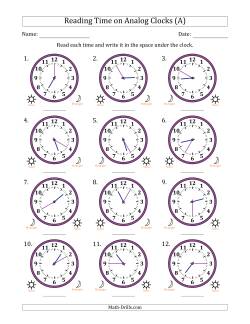
Even though the time is displayed digitally in so many places these days—on cell phones, on computers, on microwaves—there are still quite a few analog clocks around. Besides being able to tell time on an analog clock, this is probably one of the first places that students encounter a number system other than base ten. Thanks to the Babylonians et. al. we have 60 seconds in a minute and 60 minutes in an hour. Once your students master the intricacies of the time system, they can start learning about other useful number systems like hexadecimal and binary, both of which are heavily used in computer programming.
Suns and moons are included with each clock to indicate the time of day. Think of the moon as midnight and the sun as noon. If the clock has a moon (midnight) on the left and a sun (noon) on the right, then the time is between midnight and noon (AM in North America). The reverse means that the time is between noon and midnight (PM in North America).
These clock worksheets include hour and minute hands, so students who are starting to learn reading time on analog clocks only have to worry about two arms. There are a variety of intervals available depending on the level of the student. The goal is to get students to be able to tell time to the minute. There are versions with twelve clocks and versions with four large clocks.
- Reading 12 Hour Time from Clocks with Minute Hands (12 Clocks per Page) Reading 12 Hour Time in One Hour Intervals (12 Clocks) Reading 12 Hour Time in 30 Minute Intervals (12 Clocks) Reading 12 Hour Time in 15 Minute Intervals (12 Clocks) Reading 12 Hour Time in 5 Minute Intervals (12 Clocks) Reading 12 Hour Time in 1 Minute Intervals (12 Clocks)
- Reading 12 Hour Time from Clocks with Minute Hands (4 Clocks per Page) Reading 12 Hour Time in One Hour Intervals ( 4 Large Clocks ) Reading 12 Hour Time in 30 Minute Intervals ( 4 Large Clocks ) Reading 12 Hour Time in 15 Minute Intervals ( 4 Large Clocks ) Reading 12 Hour Time in 5 Minute Intervals ( 4 Large Clocks ) Reading 12 Hour Time in 1 Minute Intervals ( 4 Large Clocks )
These worksheets also include second hands in various intervals. These are best to use after students have mastered reading time to the minute. The addition of a third hand challenges them more and helps them understand how many seconds are in a minute.
- Reading 12 Hour Time from Clocks with Second Hands (12 Clocks per Page) Reading 12 Hour Time in 30 Second Intervals (12 Clocks) Reading 12 Hour Time in 15 Second Intervals (12 Clocks) Reading 12 Hour Time in 5 Second Intervals (12 Clocks) Reading 12 Hour Time in 1 Second Intervals (12 Clocks)
- Reading 12 Hour Time from Clocks with Second Hands (4 Clocks per Page) Reading 12 Hour Time in 30 Second Intervals ( 4 Large Clocks ) Reading 12 Hour Time in 15 Second Intervals ( 4 Large Clocks ) Reading 12 Hour Time in 5 Second Intervals ( 4 Large Clocks ) Reading 12 Hour Time in 1 Second Intervals ( 4 Large Clocks )
Students encounter 24 hour time in various places such as on plane tickets, in computer programming and in literature. These worksheets are similar to reading 12 hour clocks, but include a second set of numbers on the inside of the minute ticks.
- Reading 24 Hour Time from Clocks with Minute Hands (12 Clocks per Page) Reading 24 Hour Time in One Hour Intervals (12 Clocks) Reading 24 Hour Time in 30 Minute Intervals (12 Clocks) Reading 24 Hour Time in 15 Minute Intervals (12 Clocks) Reading 24 Hour Time in 5 Minute Intervals (12 Clocks) Reading 24 Hour Time in 1 Minute Intervals (12 Clocks)
- Reading 24 Hour Time from Clocks with Minute Hands (4 Clocks per Page) Reading 24 Hour Time in One Hour Intervals ( 4 Large Clocks ) Reading 24 Hour Time in 30 Minute Intervals ( 4 Large Clocks ) Reading 24 Hour Time in 15 Minute Intervals ( 4 Large Clocks ) Reading 24 Hour Time in 5 Minute Intervals ( 4 Large Clocks ) Reading 24 Hour Time in 1 Minute Intervals ( 4 Large Clocks )
These 24 hour clocks also include second hands, so students can read time represented on clocks to the nearest second.
- Reading 24 Hour Time from Clocks with Second Hands (12 Clocks per Page) Reading 24 Hour Time in 30 Second Intervals (12 Clocks) Reading 24 Hour Time in 15 Second Intervals (12 Clocks) Reading 24 Hour Time in 5 Second Intervals (12 Clocks) Reading 24 Hour Time in 1 Second Intervals (12 Clocks)
- Reading 24 Hour Time from Clocks with Second Hands (4 Clocks per Page) Reading 24 Hour Time in 30 Second Intervals ( 4 Large Clocks ) Reading 24 Hour Time in 15 Second Intervals ( 4 Large Clocks ) Reading 24 Hour Time in 5 Second Intervals ( 4 Large Clocks ) Reading 24 Hour Time in 1 Second Intervals ( 4 Large Clocks )
Once students are able to read time off of analog clocks, they can be challenged to sketch time. This might seem easy, but analog clocks tend to have a small quirk in that the hands don't always point to the exact number. For example, if it is 6:30, the hour hand will be half way between the 6 and the 7. Taking time to point this out to students will ensure they succeed on these worksheets.
- Sketching Times to Minutes on 12 Hour Analog Clocks (12 Clocks per Page) Sketching 12 Hour Time in One Hour Intervals (12 Clocks) Sketching 12 Hour Time in 30 Minute Intervals (12 Clocks) Sketching 12 Hour Time in 15 Minute Intervals (12 Clocks) Sketching 12 Hour Time in 5 Minute Intervals (12 Clocks) Sketching 12 Hour Time in 1 Minute Intervals (12 Clocks)
- Sketching Times to Minutes on 12 Hour Analog Clocks (4 Clocks per Page) Sketching 12 Hour Time in One Hour Intervals ( 4 Large Clocks ) Sketching 12 Hour Time in 30 Minute Intervals ( 4 Large Clocks ) Sketching 12 Hour Time in 15 Minute Intervals ( 4 Large Clocks ) Sketching 12 Hour Time in 5 Minute Intervals ( 4 Large Clocks ) Sketching 12 Hour Time in 1 Minute Intervals ( 4 Large Clocks )
Once students have mastered sketching in the hour and minute hands, it is time to add the second hands. As with the hour hand, the minute hand doesn't always point exactly to the minute. For example, if it is 6:30:45, the minute hand will be about 3/4 of the way to the :31 mark. If they have learned this about the hour hand already, it shouldn't be too much of a leap to get them to understand this about the minute hand.
- Sketching Times to Seconds on 12 Hour Analog Clocks (12 Clocks per Page) Sketching 12 Hour Time in 30 Second Intervals (12 Clocks) Sketching 12 Hour Time in 15 Second Intervals (12 Clocks) Sketching 12 Hour Time in 5 Second Intervals (12 Clocks) Sketching 12 Hour Time in 1 Second Intervals (12 Clocks)
- Sketching Times to Seconds on 12 Hour Analog Clocks (4 Clocks per Page) Sketching 12 Hour Time in 30 Second Intervals ( 4 Large Clocks ) Sketching 12 Hour Time in 15 Second Intervals ( 4 Large Clocks ) Sketching 12 Hour Time in 5 Second Intervals ( 4 Large Clocks ) Sketching 12 Hour Time in 1 Second Intervals ( 4 Large Clocks )
Very much the same as sketching on 12 hour clocks, these worksheets use 24 hour time.
- Sketching Times to Minutes on 24 Hour Analog Clocks (12 Clocks per Page) Sketching 24 Hour Time in One Hour Intervals (12 Clocks) Sketching 24 Hour Time in 30 Minute Intervals (12 Clocks) Sketching 24 Hour Time in 15 Minute Intervals (12 Clocks) Sketching 24 Hour Time in 5 Minute Intervals (12 Clocks) Sketching 24 Hour Time in 1 Minute Intervals (12 Clocks)
- Sketching Times to Minutes on 24 Hour Analog Clocks (4 Clocks per Page) Sketching 24 Hour Time in One Hour Intervals ( 4 Large Clocks ) Sketching 24 Hour Time in 30 Minute Intervals ( 4 Large Clocks ) Sketching 24 Hour Time in 15 Minute Intervals ( 4 Large Clocks ) Sketching 24 Hour Time in 5 Minute Intervals ( 4 Large Clocks ) Sketching 24 Hour Time in 1 Minute Intervals ( 4 Large Clocks )
- Sketching Times to Seconds on 24 Hour Analog Clocks (12 Clocks per Page) Sketching 24 Hour Time in 30 Second Intervals (12 Clocks) Sketching 24 Hour Time in 15 Second Intervals (12 Clocks) Sketching 24 Hour Time in 5 Second Intervals (12 Clocks) Sketching 24 Hour Time in 1 Second Intervals (12 Clocks)
- Sketching Times to Seconds on 24 Hour Analog Clocks (4 Clocks per Page) Sketching 24 Hour Time in 30 Second Intervals ( 4 Large Clocks ) Sketching 24 Hour Time in 15 Second Intervals ( 4 Large Clocks ) Sketching 24 Hour Time in 5 Second Intervals ( 4 Large Clocks ) Sketching 24 Hour Time in 1 Second Intervals ( 4 Large Clocks )
Converting Time
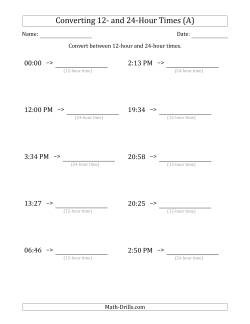
It is a very useful skill to be able to convert between 12 and 24 hour time in a global world. Even in places, like the U.S., where 12 hour time is used a lot, students still see time formatted in 24 hour time in a wide variety of situations.
- Converting Between 12- and 24-Hour Times Converting 12- to 24-Hour time Converting 24- to 12-Hour time Converting Between 12- and 24-Hour time
Converting between time units worksheets are useful to test students understanding of time measurement and to give them more practice.
- Converting Between Seconds, Minutes, Hours, Days and Weeks (one step up or down) Converting between seconds, minutes and hours (one step up or down) Converting between seconds, minutes, hours and days (one step up or down) Converting between seconds, minutes, hours, days and weeks (one step up or down)
- Converting Between Seconds, Minutes, Hours, Days and Weeks (one or two steps up or down) Converting between seconds, minutes and hours (one- or two-steps up or down) Converting between seconds, minutes, hours and days (one- or two-steps up or down) Converting between seconds, minutes, hours, days and weeks (one- or two-steps up or down)
Elapsed Time Worksheets
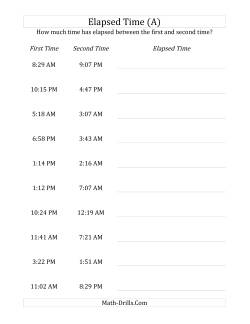
Elapsed time refers to the amount of time that has passed between a start time and a finish time. This can be challenging to students if they are not completely familiar with the base 60 system used for second, minutes and hours, and the fact that there are 24 hours a day sometimes split into morning and afternoon times.
- Elapsed Time to Minutes Elapsed Time with 1 Minute Intervals; Max 5 Hours Elapsed Time with 5 Minute Intervals; Max 5 Hours Elapsed Time with 15 Minute Intervals; Max 5 Hours Elapsed Time with 1 Minute Intervals; Max 24 Hours Elapsed Time with 5 Minute Intervals; Max 24 Hours Elapsed Time with 15 Minute Intervals; Max 24 Hours
- Elapsed Time to Seconds Elapsed Time with 1 Minute/Second Intervals; Max 5 Hours Elapsed Time with 5 Minute/Second Intervals; Max 5 Hours Elapsed Time with 15 Minute/Second Intervals; Max 5 Hours Elapsed Time with 1 Minute/Second Intervals; Max 24 Hours Elapsed Time with 5 Minute/Second Intervals; Max 24 Hours Elapsed Time with 15 Minute/Second Intervals; Max 24 Hours
The elapsed date worksheets in this section are based on a three column table with ten rows. Each different version of the elapsed date table will challenge students in different ways. The worksheets that ask students to find the end date are given a start date and an elapsed time. These worksheets work well for starting at a specific point and counting up. The worksheets that ask students to find the start date, elapsed time or the end date will have random blanks in the table, so students may have to figure out the elapsed time forwards or backwards. Below you will find various challenges including elapsed time with days only, then we progressively add weeks, months, and years to the worksheets.
Please note that when finding future dates, it is important to start with the largest unit first and progress to the smaller units. For example, if the start date is February 8, 2020 and the elapsed time is 3 years, 2 months, 3 weeks and 6 days, you would add the three years first to get February 8, 2023. Next, add the months to get April 8, 2023. Finally, add the weeks and days to get May 5, 2023. You can add the weeks and days together as they are both exact lengths whereas years and months vary in size.
- Calculate End Dates from Start Dates and Elapsed Times in Days, Weeks, Months and Years Calculate End Date for Various Elapsed Days Calculate End Date for Various Elapsed Days + Weeks Calculate End Date for Various Elapsed Days + Weeks + Months Calculate End Date for Various Elapsed Days + Weeks + Months + Years
- Calculate Elapsed Time Between Two Dates in Days, Weeks, Months and Years Calculate Elapsed Time Between Two Dates in Days Calculate Elapsed Time Between Two Dates in Days + Weeks Calculate Elapsed Time Between Two Dates in Days + Weeks + Months Calculate Elapsed Time Between Two Dates in Days + Weeks + Months + Years
- Calculate Start Dates from End Dates and Elapsed Time in Days, Weeks, Months and Years Calculate Start Date from End Date and Elapsed Time in Days Calculate Start Date from End Date and Elapsed Time in Days + Weeks Calculate Start Date from End Date and Elapsed Time in Days + Weeks + Months Calculate Start Date from End Date and Elapsed Time in Days + Weeks + Months + Years
- Calculate Various Start Dates, Elapsed Time or End Dates with Days, Weeks, Months and Years Calculate Start Date, Elapsed Time or End Date (Days) Calculate Start Date, Elapsed Time or End Date (Days + Weeks) Calculate Start Date, Elapsed Time or End Date (Days + Weeks + Months) Calculate Start Date, Elapsed Time or End Date (Days + Weeks + Months + Years)
Adding and Subtracting Time
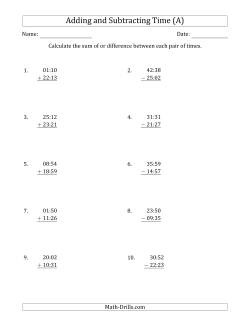
Adding and subtracting time is similar to adding any numbers, but the regrouping amounts are different. If you think of the decimal system, numbers are divided into places named: ones, tens, hundreds, etc. In time values, the places have different values based on an ancient Babylonian numbering system with a base of 60. In the "seconds place," there are 60 unique seconds from 0 to 59. The same is true for the "minutes place." The "hours place" can vary from 24 if one is interested in counting days as well, or can be greater than 24 if the largest place value is in the hours place. In these worksheets, students are challenged to regroup seconds and minutes as they add or subtract two time amounts.
- Adding and Subtracting Hours and Minutes Adding Hours and Minutes (Compact Format) Adding Hours and Minutes (Long Format) Subtracting Hours and Minutes (Compact Format) Subtracting Hours and Minutes (Long Format) Adding and Subtracting Hours and Minutes (Compact Format) Adding and Subtracting Hours and Minutes (Long Format)
- Adding and Subtracting Hours, Minutes and Seconds Adding Hours, Minutes and Seconds (Compact Format) Adding Hours, Minutes and Seconds (Long Format) Subtracting Hours, Minutes and Seconds (Compact Format) Subtracting Hours, Minutes and Seconds (Long Format) Adding and Subtracting Hours, Minutes and Seconds (Compact Format) Adding and Subtracting Hours, Minutes and Seconds (Long Format)
Copyright © 2005-2024 Math-Drills.com You may use the math worksheets on this website according to our Terms of Use to help students learn math.
Filter Results
- clear all filters
Resource Type
- Guided Lessons
- Lesson Plans
- Hands-on Activities
- Interactive Stories
- Online Exercises
- Printable Workbooks
- Science Projects
- Song Videos
middle-school
- Fine arts
- Foreign language
- Number Sense
- Addition
- Subtraction
- Multiplication
- Division
- Mixed Operations
- Fractions
- Decimals
- Percents, Ratios, and Rates
- Algebra
- Geometry
- Measurement
- Days, Weeks, and Months on a Calendar
- Time to the Hour
- Time to the Half Hour
- Time to the Quarter Hour
- Time to the Nearest Five Minutes
- Time to the Minute
- Elapsed Time
- Money Math
- Data and Graphing
- Math Word Problems
- Math Puzzles
- Reading & Writing
- Science
- Social emotional
- Social studies
- Typing
- Arts & crafts
- Coloring
- Holidays
- Offline games
- Pop Culture & Events
- Seasonal
- Common Core
Telling Time Resources

An online Pomodoro Timer to boost your productivity
What is pomofocus.
Pomofocus is a customizable pomodoro timer that works on desktop & mobile browser. The aim of this app is to help you focus on any task you are working on, such as study, writing, or coding. This app is inspired by Pomodoro Technique which is a time management method developed by Francesco Cirillo.
What is Pomodoro Technique?
The Pomodoro Technique is created by Francesco Cirillo for a more productive way to work and study. The technique uses a timer to break down work into intervals, traditionally 25 minutes in length, separated by short breaks. Each interval is known as a pomodoro, from the Italian word for 'tomato', after the tomato-shaped kitchen timer that Cirillo used as a university student. - Wikipedia
How to use the Pomodoro Timer?
- Add tasks to work on today
- Set estimate pomodoros (1 = 25min of work) for each tasks
- Select a task to work on
- Start timer and focus on the task for 25 minutes
- Take a break for 5 minutes when the alarm ring
- Iterate 3-5 until you finish the tasks
Basic Features
- Estimate Finish Time: Get an estimate of the time required to complete your daily tasks.
- Add Templates: Save your repetitive tasks as templates and add them with just one click.
- Visual Reports: See how much time you've focused each day, week, and month.
- Custom Settings: Personalize your focus/break time, alarm sounds, background sounds, and more.
Premium Features
- Add Projects: Track how much time you spend on each project.
- Yearly Reports: View your focus hours for each year.
- Download Reports: Download your focus history in CSV format.
- No Template Limit: Save more than 3 templates.
- Todoist Integration: Load tasks from your Todoist account.
- Webhook Integration: Connect to other apps (Zapier, IFTTT, etc).
- No Ads: Enjoy a clean and distraction-free app experience.
Download App
- For macOS (zip file) *Right click the icon to open
- For Windows (zip file)

Reading & Math for K-5
- Kindergarten
- Learning numbers
- Comparing numbers
- Place Value
- Roman numerals
- Subtraction
- Multiplication
- Order of operations
- Drills & practice
- Measurement
- Factoring & prime factors
- Proportions
- Shape & geometry
- Data & graphing
- Word problems
- Children's stories
- Leveled Stories
- Sentences & passages
- Context clues
- Cause & effect
- Compare & contrast
- Fact vs. fiction
- Fact vs. opinion
- Main idea & details
- Story elements
- Conclusions & inferences
- Sounds & phonics
- Words & vocabulary
- Reading comprehension
- Early writing
- Numbers & counting
- Simple math
- Social skills
- Other activities
- Dolch sight words
- Fry sight words
- Multiple meaning words
- Prefixes & suffixes
- Vocabulary cards
- Other parts of speech
- Punctuation
- Capitalization
- Narrative writing
- Opinion writing
- Informative writing
- Cursive alphabet
- Cursive letters
- Cursive letter joins
- Cursive words
- Cursive sentences
- Cursive passages
- Grammar & Writing
Breadcrumbs
- Telling time
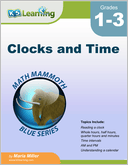
Download & Print Only $5.30
2nd Grade Math Worksheets: Telling Time
Time and calendar worksheets.
These grade 2 worksheets help students learn to read a traditional (analog) clock-face . We begin with "whole hours" (3 o'clock, etc.) and progress to half fours, quarter hours and 5 and 1 minute intervals. We also cover the units of time , am & pm , and elapsed time . Finally, we introduce the days of the week and months of the year .
|
|
|
| (seconds, minutes, ... ) | |
| 3:14 p.m., 9:30 a.m. | |
|
| |
| bedtime --> | |
| Friday, Saturday, Sunday | |
| May - June - July | |

Sample Grade 2 Telling Time Worksheet
More time and calendar worksheets
Explore all of our time worksheets , from understanding units of time to reading clocks and calendars.
What is K5?
K5 Learning offers free worksheets , flashcards and inexpensive workbooks for kids in kindergarten to grade 5. Become a member to access additional content and skip ads.

Our members helped us give away millions of worksheets last year.
We provide free educational materials to parents and teachers in over 100 countries. If you can, please consider purchasing a membership ($24/year) to support our efforts.
Members skip ads and access exclusive features.
Learn about member benefits
This content is available to members only.
Join K5 to save time, skip ads and access more content. Learn More
- Forgot Password?
- Grades 6-12
- School Leaders
Win a $500 Oriental Trading Gift Card ✨
Every product is independently selected by (obsessive) editors. Things you buy through our links may earn us a commission.
33 Fun Telling-Time Games and Activities
Time flies when you’re having fun!
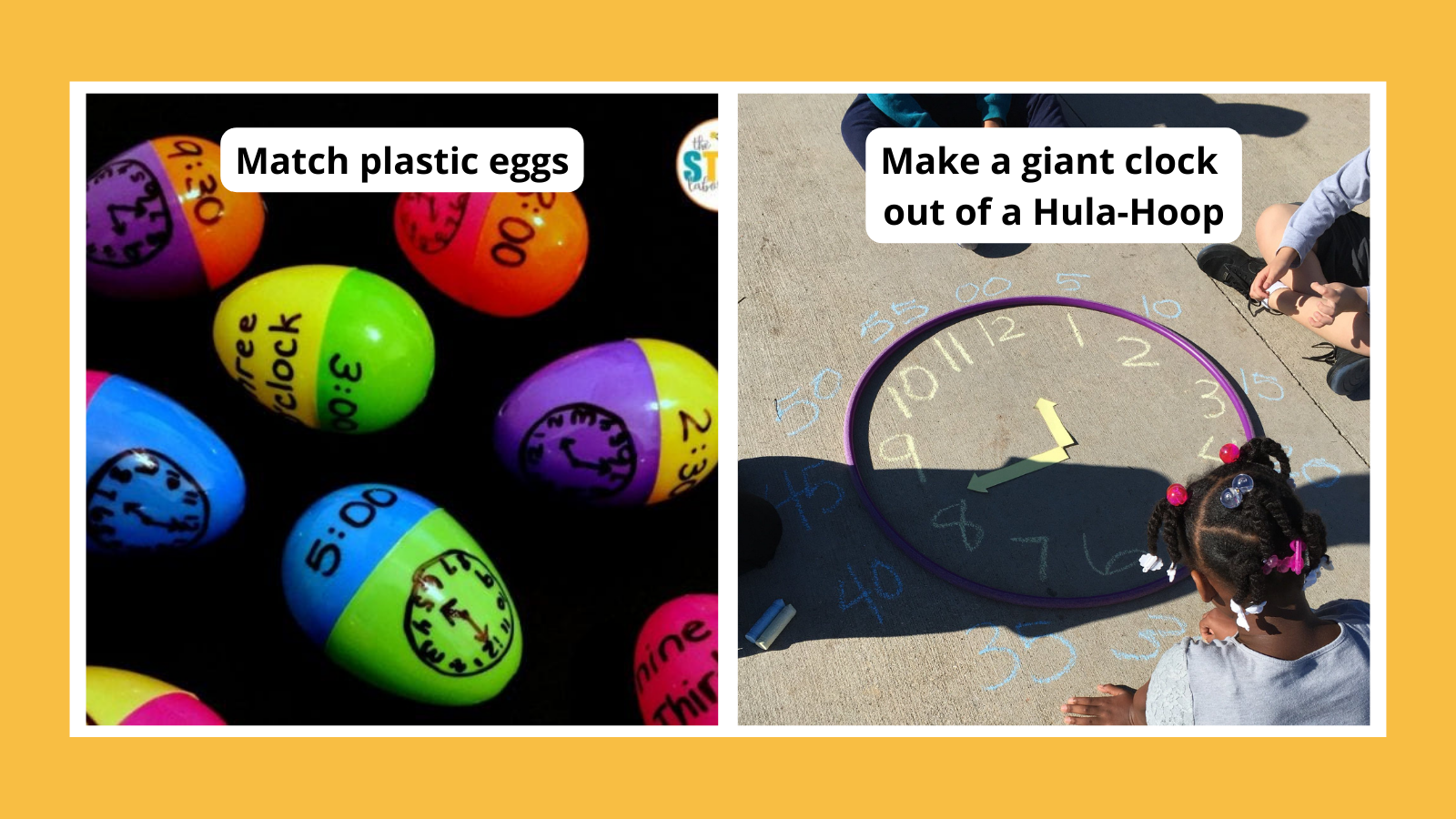
Learning to tell time is an important early math lesson since it’s a real-world skill that’s used every day by everyone. Learning about minutes and hours can become tedious fast, so you’ll want to have a lot of creative and hands-on ways to bring it to life for kids. Regardless of whether you get crafty with a paper watch or active with musical clocks, we think your students will be sure to have a good time learning all things time. There are, of course, old standbys on our list too like books and worksheets. Kids can even get in some extra practice with a free online game or two. Check out our personal favorite telling-time games to try with the kiddos in your life.
Hands-On Activities for Telling Time
Online Telling-Time Games
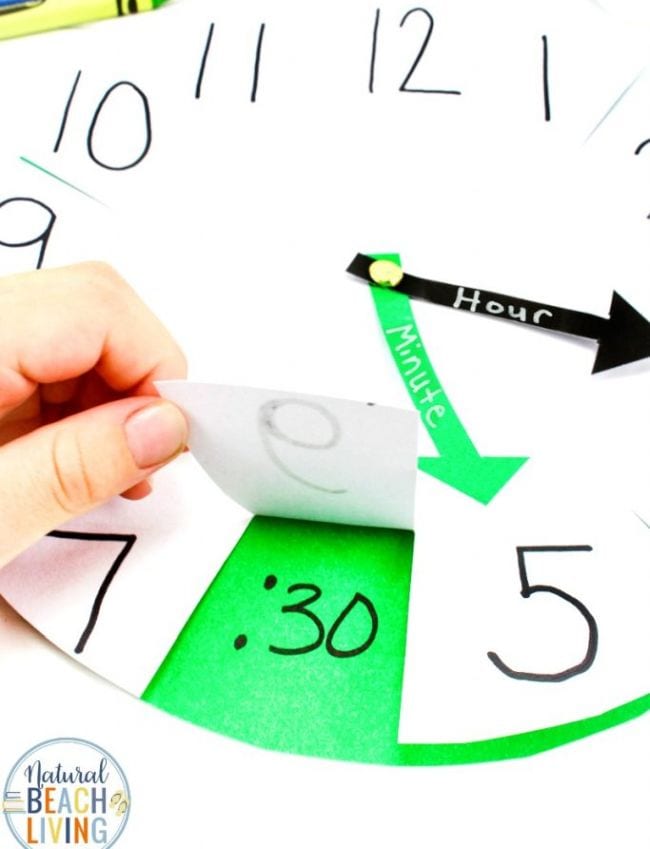
1. Make a paper clock
One of the trickier aspects of telling time is understanding how the number 1 also means 5 minutes, the number 2 means 10 minutes, and so on. This paper clock activity helps students make that connection. (Pro tip: Use paper plates to make this craft even easier.)
Get tutorial: How to Make a Clock to Teach Time
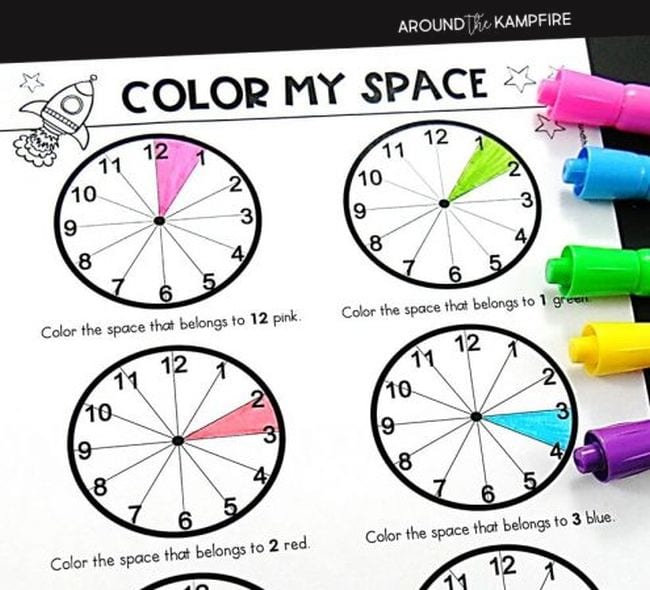
2. Color the spaces to learn the hours
Another important concept kids need to grasp is how the spaces between the numbers work on an analog clock. These coloring games are a simple way to teach kids about telling time, but it helps drive the point home. Grab the free printable at the link.
Learn more: Teaching Kids to Tell Time Past the Hour

3. Put a puzzle together
Use these telling-time puzzle games to demonstrate different ways of showing the same time. We especially love this version .
Learn more: How To Teach Telling Time in Second Grade
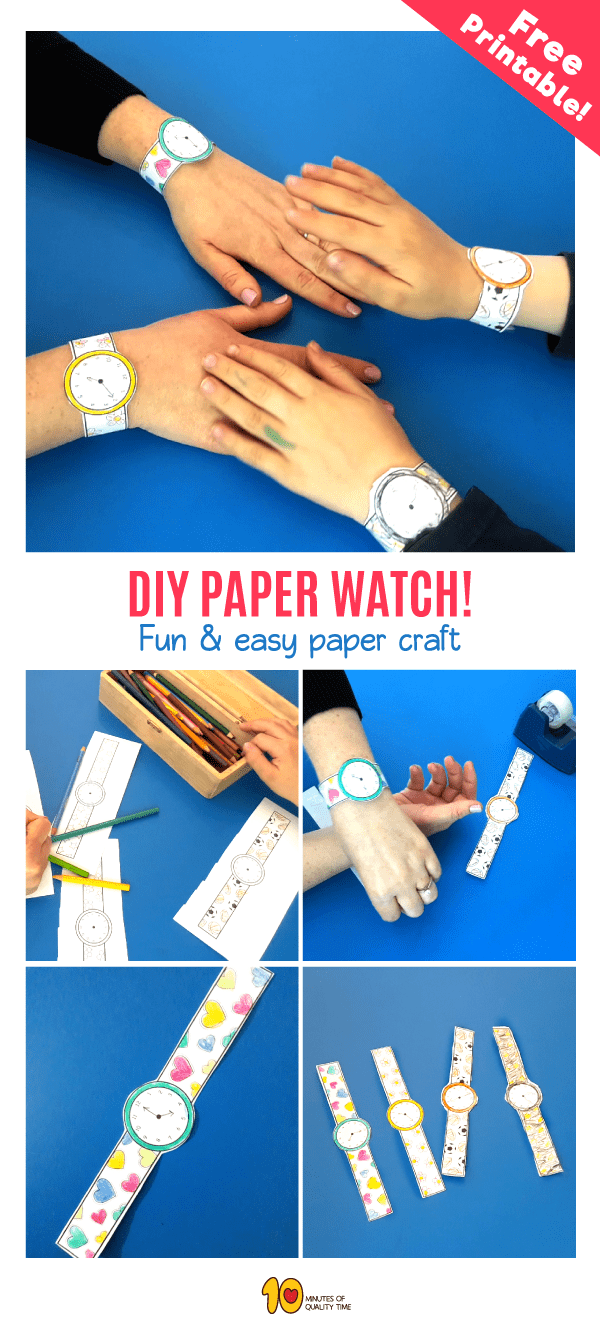
4. Wear paper watches
First, print and cut out the free printable paper watches available at the link below. Draw hands on each clock face and record what time each student’s watch reads on a master record sheet. Have kids decorate their watch bands, then fasten them on their wrists and add the clock faces. Give each student a record sheet, then let them go around the room and ask each of their classmates, “What time is it?” They look at their classmate’s watch and record the time. Check their results against your master.
Get tutorial: Paper Watch Craft for Kids
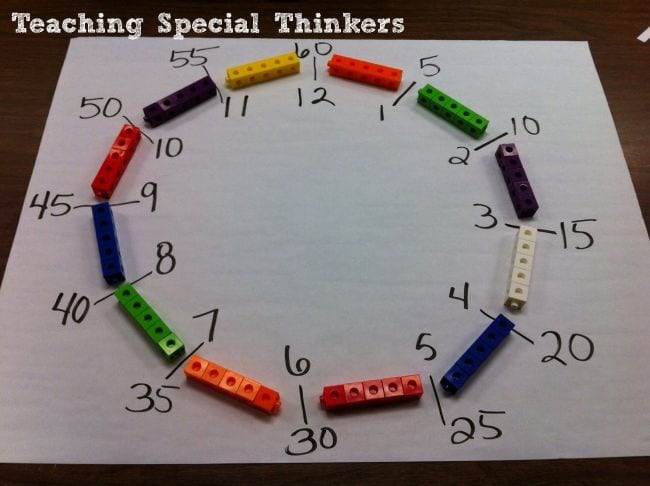
5. Make a clock with linking math cubes
This telling-time game helps kids understand time both as a circular analog clock and a time line moving forward. Gather your math cubes and visit the link to see how it works.
Learn more: Telling Time Is Easy Peasy
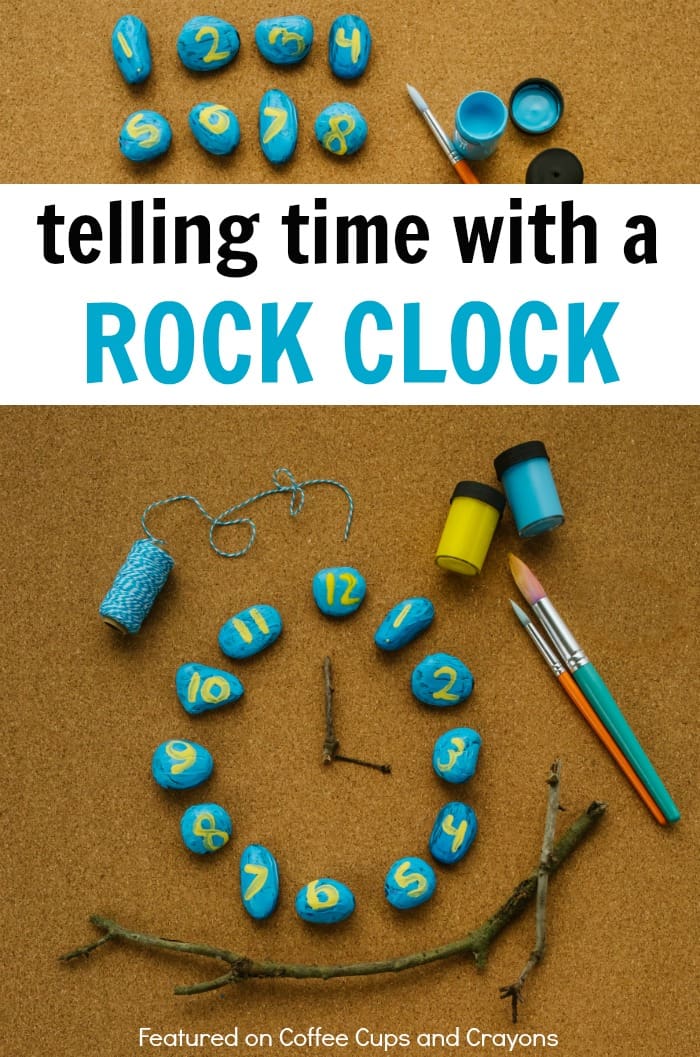
6. Make a rock clock
Part art lesson, part math, and part science, this is the ultimate time-telling activity. First, get outside to collect the sticks and rocks. Second, have kids paint their rocks with acrylic paint. Finally, have them set their “clocks” to different times.
Get tutorial: Teach Kids How To Tell Time
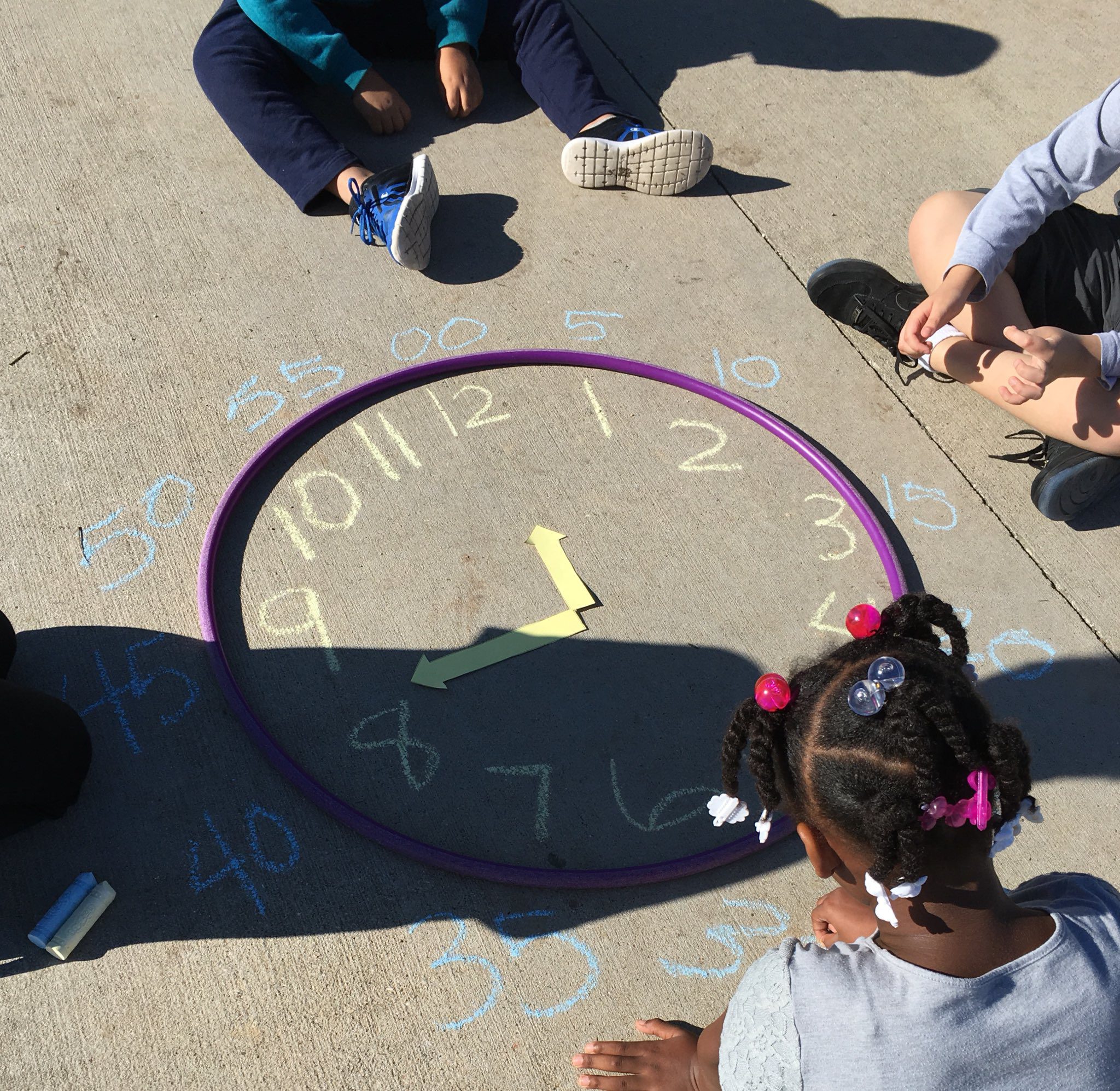
7. Take it outside with a Hula-Hoop clock
Pull out the sidewalk chalk and head outside for some time-telling practice. Hula-Hoops make perfect analog clocks, but if you don’t have any, you can still let kids play fun time-telling games by simply drawing circles instead.
Learn more: Hula-Hoop and Chalk Clocks
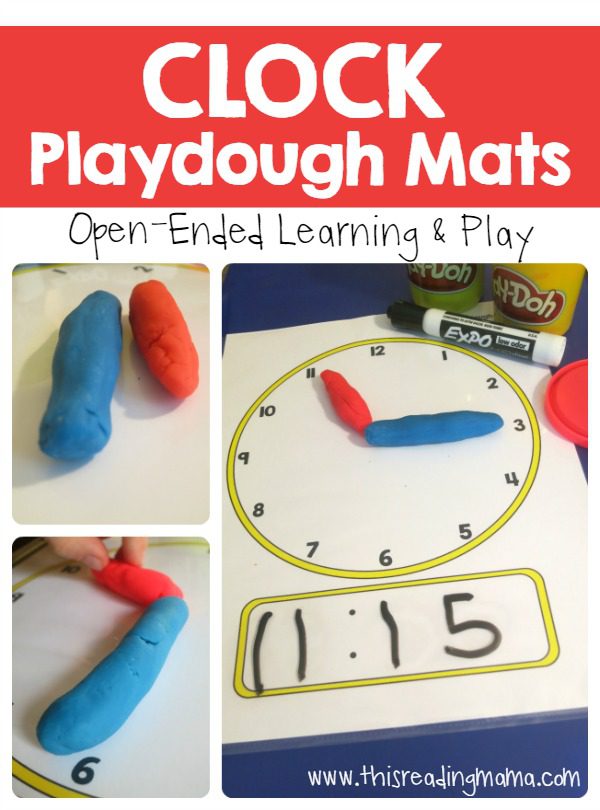
8. Set the time with play dough
Create time-telling activity mats by printing a page similar to the one shown here and then placing it in a plastic sleeve or laminating it. Finally, challenge your students to roll out play dough to create the hands of the clock and “set” it to the designated time.
Learn more: Telling Time—Clock Play Dough Mats

9. Dance around for musical clocks
If your students love games like musical chairs, you can make it an educational time-telling activity. Start by printing out our free blank clock sheets . Pass them out and have each student draw a time on their clock, then leave it on their desk. Give each student a recording sheet (included with the clock printable), then have them grab a pencil and get ready to move! Start the music and let kids dance around from desk to desk. Stop the music and instruct them to record the name and time on the clock of the desk in front of them. Start the music again and keep on going!
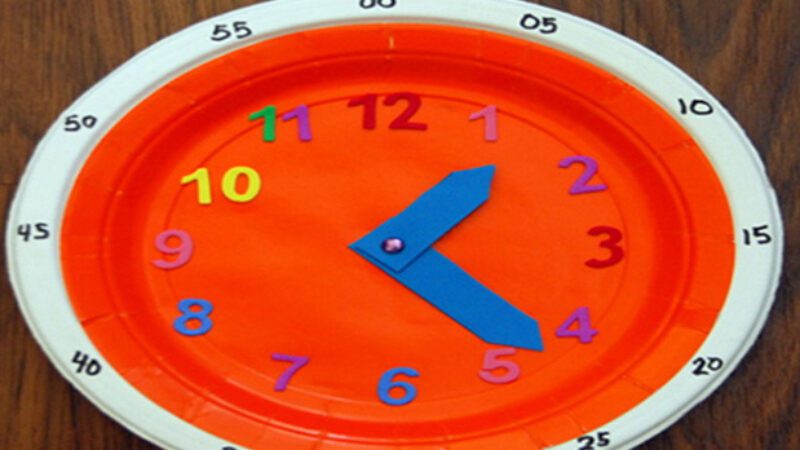
10. Turn a paper plate into a clock
We love how simple this project is to re-create since all you really need are some paper plates, markers, and a metal fastener. The numbers on the outer edge help your students make the connection between the minute hand and the spoken or digital time.
Get tutorial: Make a Paper Plate Clock
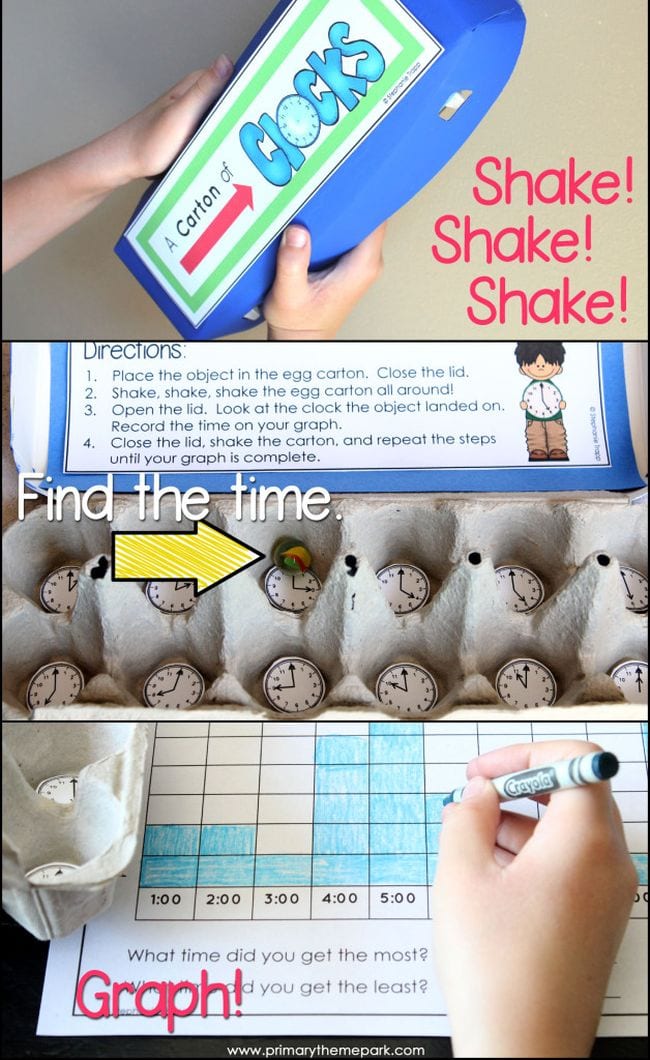
11. Shake up a carton of clocks
This awesome time-telling game also gives kids some practice at creating bar graphs. First, paste analog clock faces showing various times into the bottoms of an empty egg carton, and add a marble or other small toy. Kids shake up the carton, look to see what time the marble landed on, and graph their results.
Get tutorial: Time Activities for First Grade

12. Add a hook to the hour hand
This time-telling trick will help your students remember that as the hour and minute hands move around, the hour still belongs to the number behind. Clever!
Learn more: Teaching Kids To Tell Time Past the Hour

13. Write the room with I Spy Time
Post paper analog clocks with times filled in around the room. Students find each clock and record the time on their record sheet. For more of a challenge, write “What will the time be in ____ minutes?” underneath each clock. After students record the time showing, they calculate the future time too. Your students will have fun learning to tell time with these games.
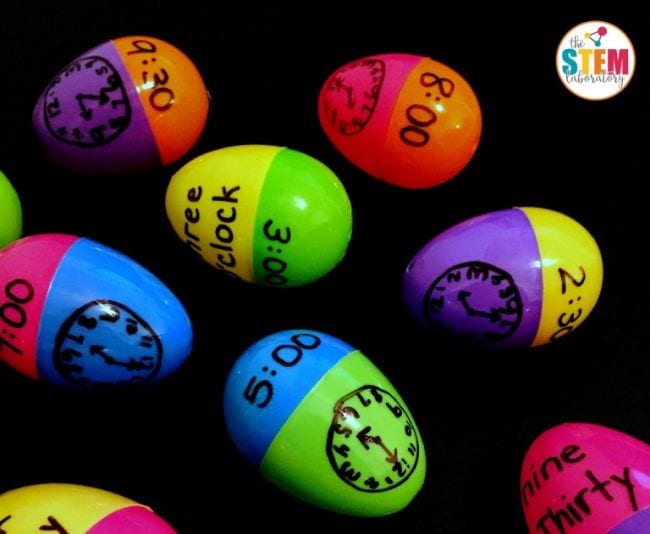
14. Match up plastic eggs
Plastic eggs have so many uses in the classroom. For time-telling practice, make them into games. Just draw analog clocks on one half and write times (in words or digital time) on the other, then have kids match them up.
Learn more: Telling Time Match Up
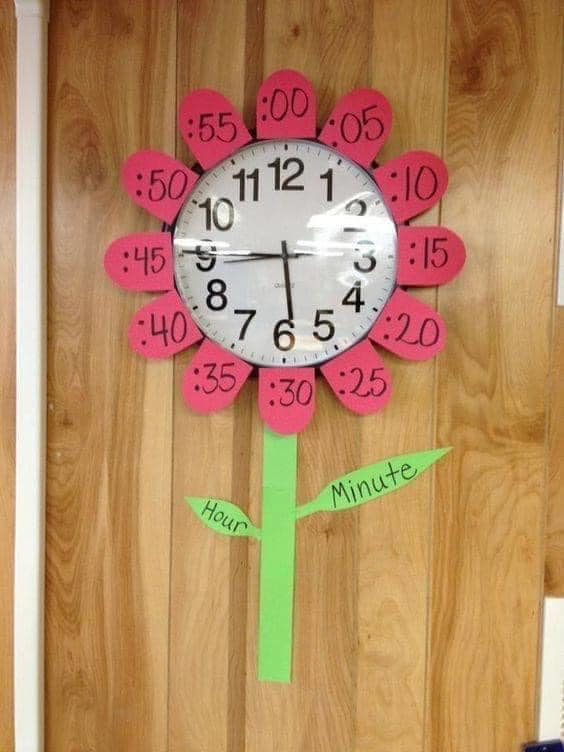
15. Turn your classroom clock into a flower
Turn a classroom wall clock into a pretty flower that will help your students make better sense of what they are looking at. We especially love the cute way the stem reinforces which is the hour and which is the minute hand.
Get tutorial: The Best Ideas for Kids
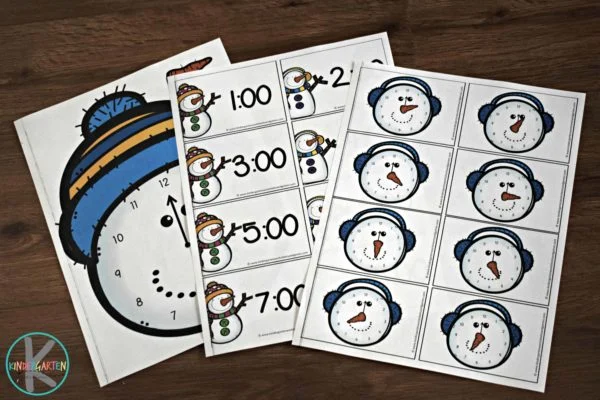
16. Chill out with frosty clocks
Turn a snowman face into an analog clock. Use these free printables for a variety of wintry time-telling activities.
Learn more: Free Snowman Telling Time Activity
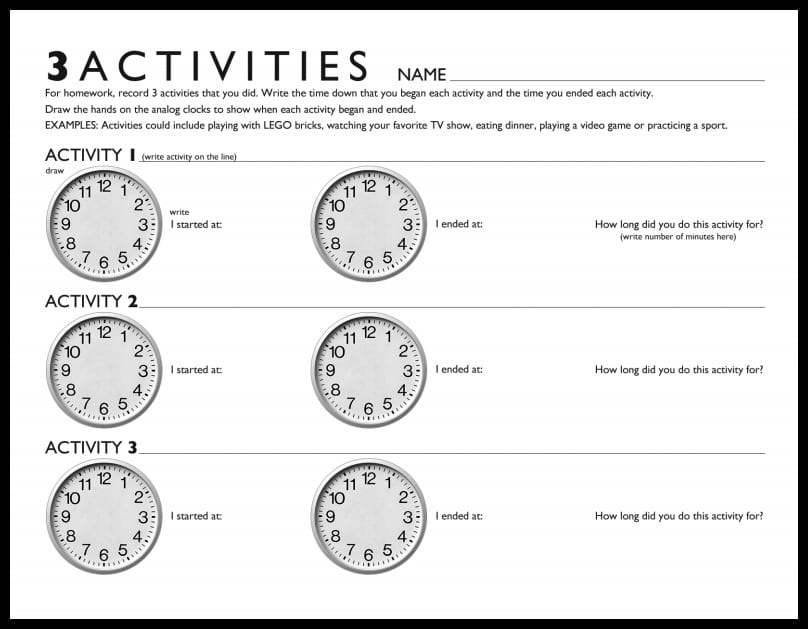
17. Calculate the duration of your favorite activities
Ready to tackle elapsed time? Have students use this free printable worksheet to record the time they spend on three different activities, at home or at school. Think: basketball practice, dance class, watching their favorite TV show, eating a banana—or doing their homework.
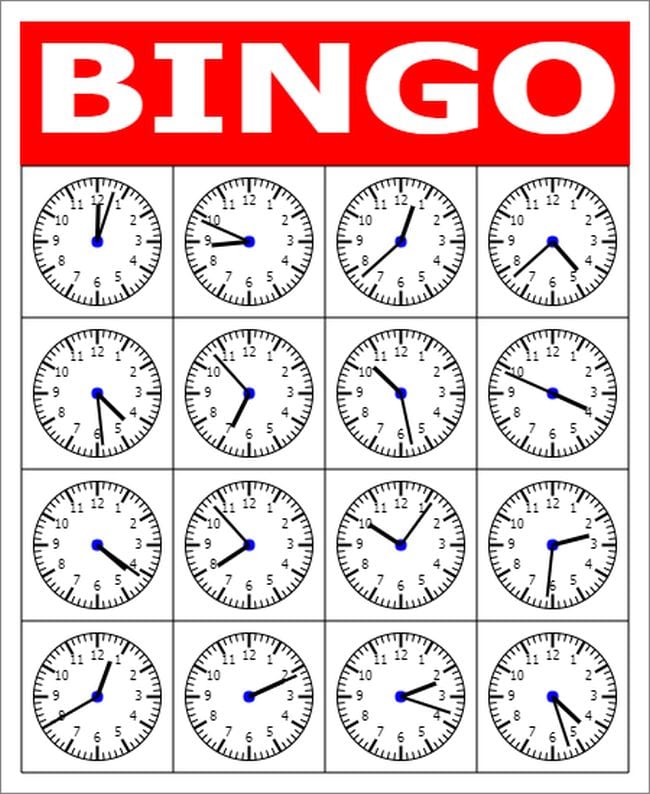
18. Compete to win Telling-Time Bingo
Bingo games are always a blast in the classroom, and there’s a variation you can play that’s focused on telling time. These analog clock bingo cards are customizable, so you can set them to match whatever time skills your students are working on, whether it’s hours, half hours, quarter hours, or to the minute.
Learn more: Telling Time Bingo Cards Maker
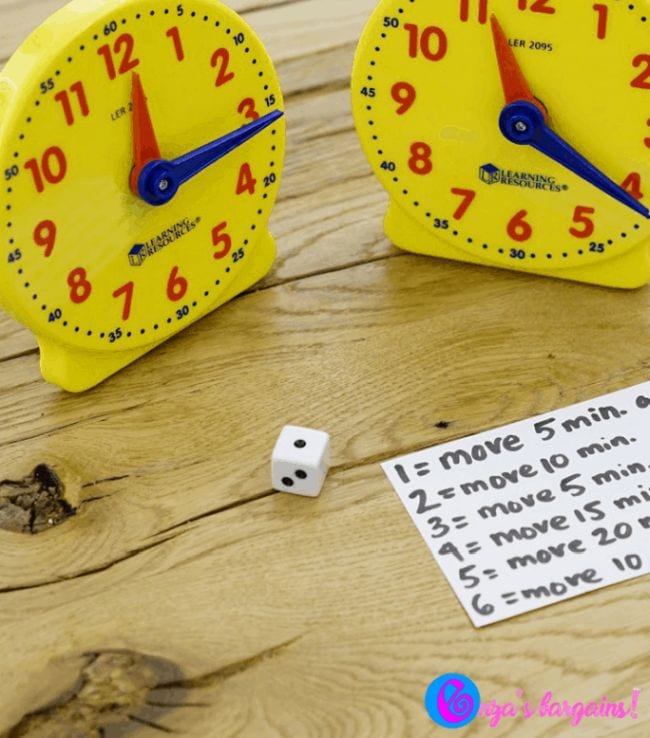
19. Race to beat the Rush Hour clock
Use toy clocks and a die to see who can reach a goal time first. Start at 12:00 and choose the target time. Students roll the die and move their clocks ahead the specified number of minutes on each turn. Students love these time-telling games!
Learn more: Rush Hour Games
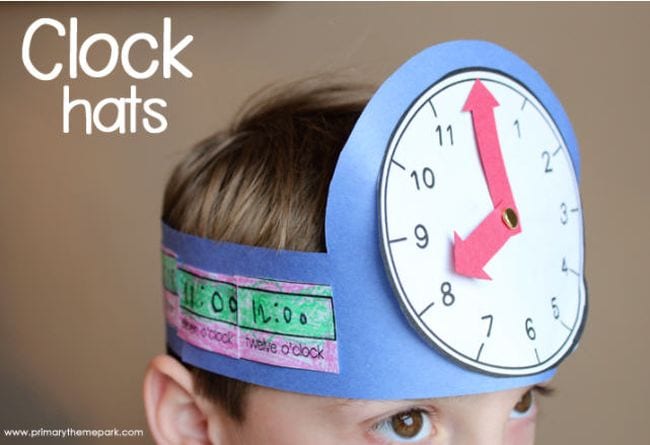
20. Don clock headbands
These clock headbands are fun to wear, and they’re also perfect for a game of “What Time Am I?” Kids ask each other questions to try to guess what time is showing on their forehead clock.
Learn more: Time Activities for First Grade
21. Distinguish between a.m. and p.m.
This free printable is perfect for teaching the difference between a.m. and p.m. Students will relate to the activities on the worksheet and therefore connect the dots between what time of day they would typically do them.
Learn more: Telling Time: AM and PM
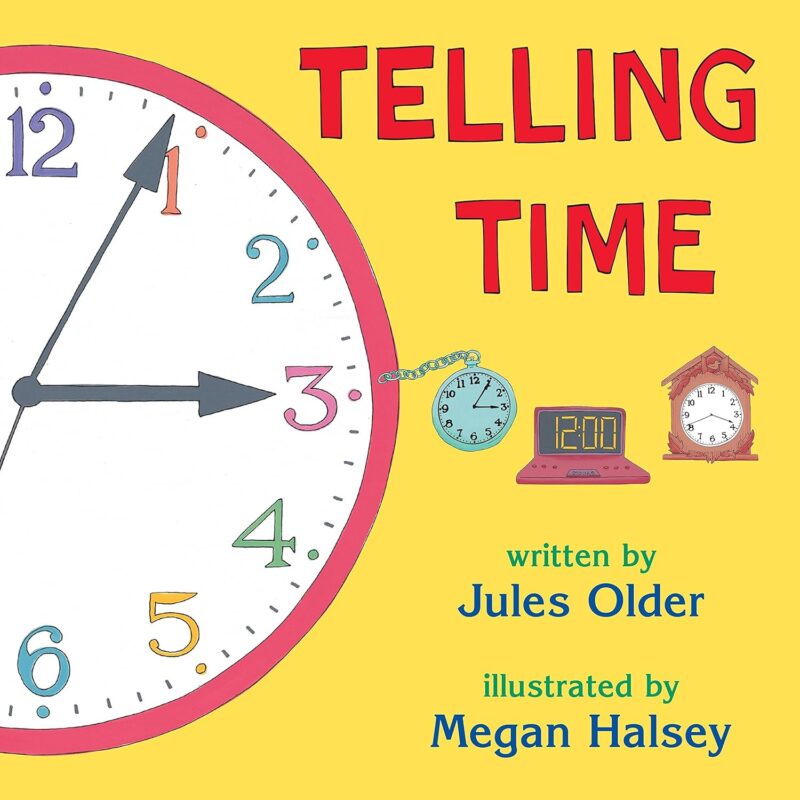
22. Read books about telling time
Books are a great way to teach about so many different topics, and telling time is certainly no exception! Pick a few of your favorites and read them aloud during story time.
Buy it: Telling Time by Jules Older
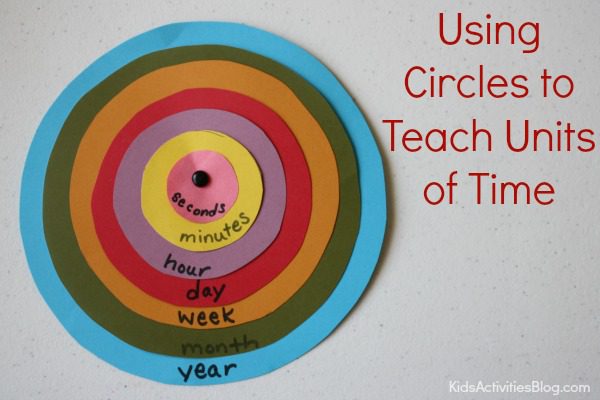
23. Teach units of time with concentric circles
We love this activity since telling time is much more than just minute and hour hands on a clock. The visual representation of the smallest unit to the largest unit (and the different colors) will help students make sense of the various units of time.
Get tutorial: Tell Time: Learning Units of Time With Concentric Circles (Printable)
Online Time Telling Games
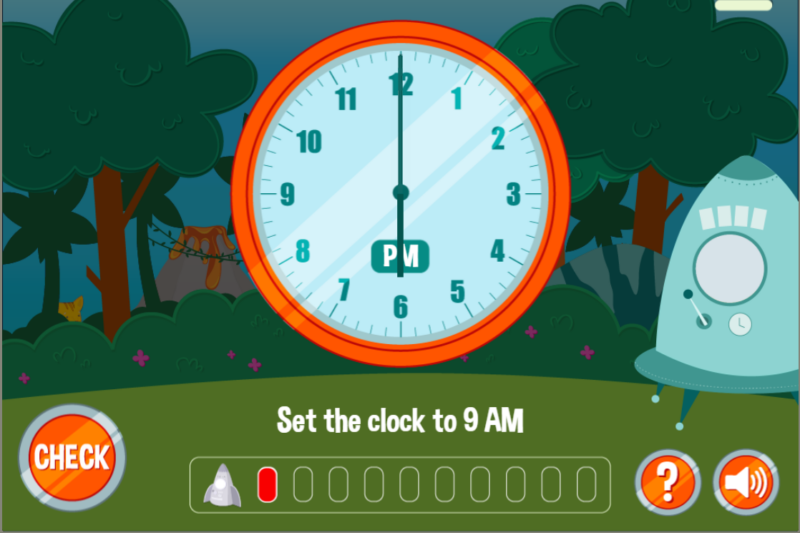
24. Travel through time
ABCya has a lot of free online games for young kids that you can play even without a subscription. This fun time-travel game allows kids to choose whether they want to practice setting a digital or an analog clock. We especially love the time-traveling theme and the cute cartoon graphics that make this activity extra kid-friendly.
Learn more: Time Travel Game
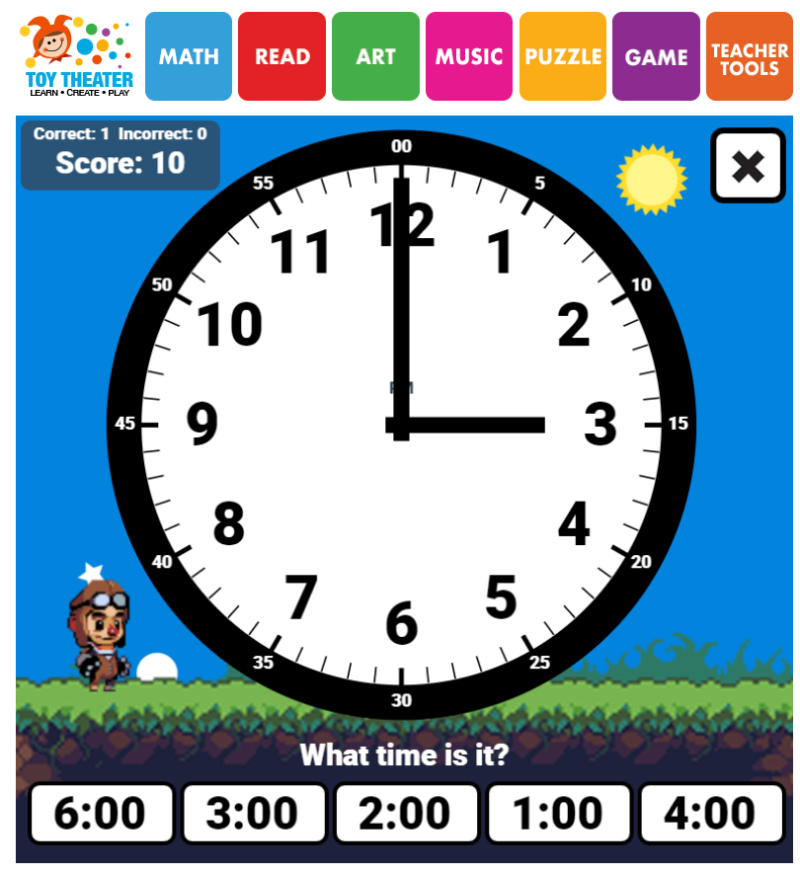
25. Pick the right answer
This simple and free game doesn’t even require a sign-up to begin playing. We love that kids are given multiple choice options to select from when guessing the time displayed on the analog clock. Kids receive 10 points for every correct answer given and are deducted 10 points for incorrect ones. We think kids will have fun trying to beat their high scores!
Learn more: Telling Time
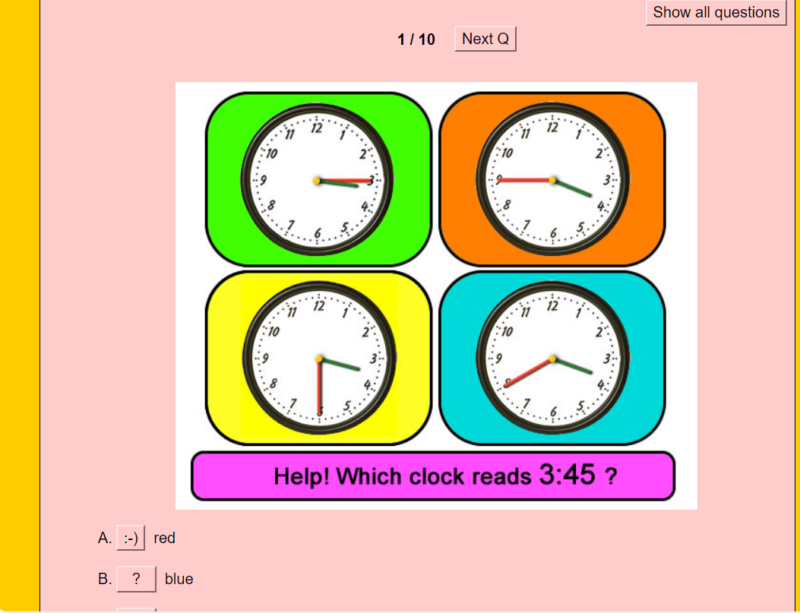

26. Tell time to the quarter hour
This site has a lot of different online time-telling activities across different difficulty levels. We are especially fond of the one that requires students to tell time to the quarter of an hour. Kids are presented with four different analog clock faces and asked to select which one displays the time at the bottom.
Learn more: Clockworks Practice
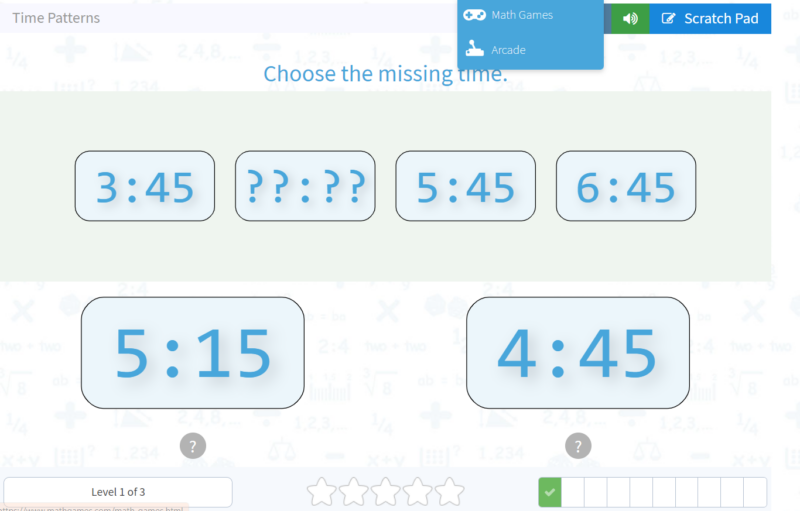
27. Recognize patterns
We love that this game combines learning time with pattern recognition. This website has additional time-telling games should the kids in your life master this one!
Learn more: Time Patterns
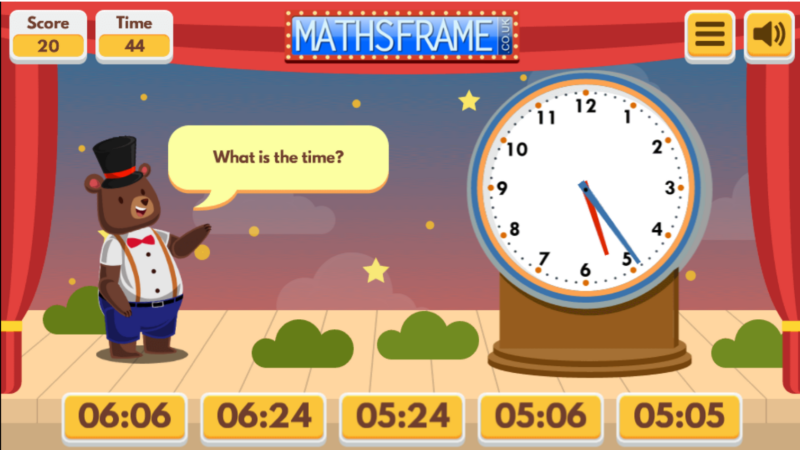
28. Personalize the learning experience
This free online game offers up a lot of room for personalization. You can select whether to identify time to the nearest hour, half hour, quarter of an hour, or even minute. You can also select a 12-hour or 24-hour clock. Depending on your child’s skill level, you can also select to play in timed or untimed modes. The adorable circus theme and bear ringmaster will keep any kid entertained!
Learn more: Telling the Time
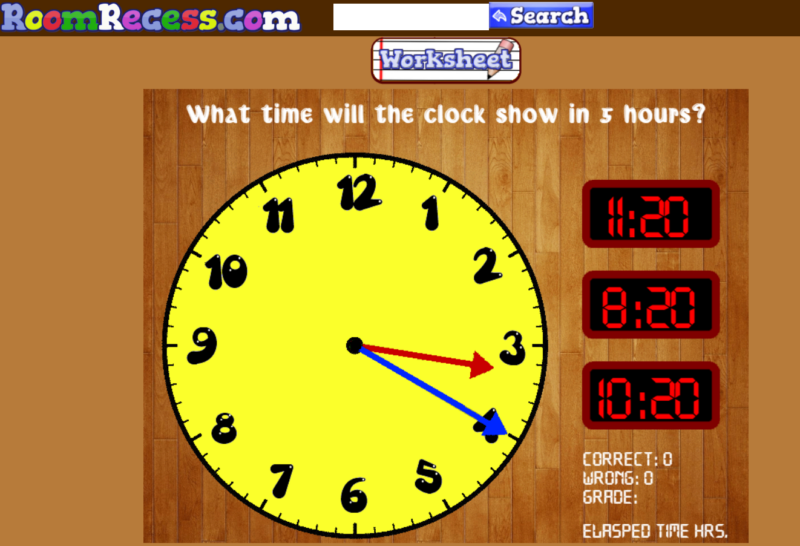
29. Practice with elapsed time
Telling-time games that go beyond just identifying a time on a clock are some of our favorites for older kids. This one requires kids to identify the time on an analog clock and then decipher what time it will be in a certain number of hours.
Learn more: Time Teller
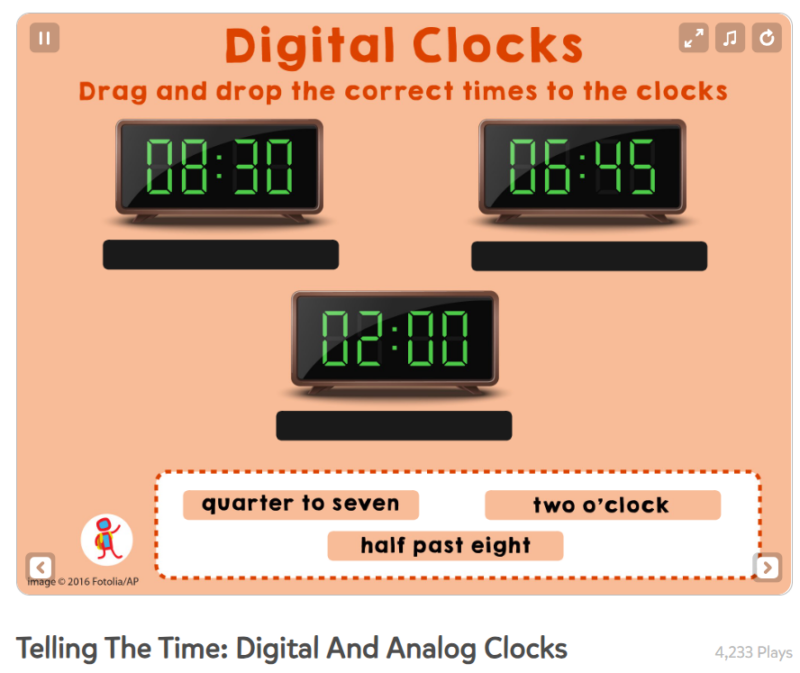
30. Compare digital and analog
This site begins by explaining the differences between digital and analog clocks as well as how to read each one. It then takes you through various exercises to test your understanding.
Learn more: Telling the Time: Digital and Analog
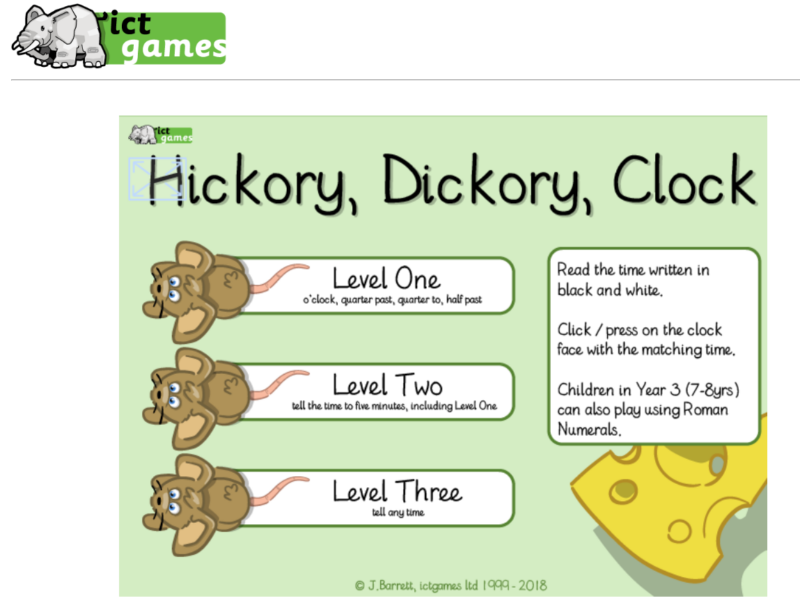
31. Make the mouse run up the clock
This is such a fun spin on identifying the time on a clock. We love the play on a classic nursery rhyme and the oh-so adorable mouse and cat graphics. Guess the right time on the cartoon grandfather clock and a cute mouse will run up it. But get it wrong and an angry cat will make itself known!
Learn more: Hickory, Dickory, Clock
32. Take a quiz
This video is advertised as being for English language learners, but it would work equally well for kids just learning to read clocks. Kids can just watch it or they can keep some scrap paper handy to record their answers.
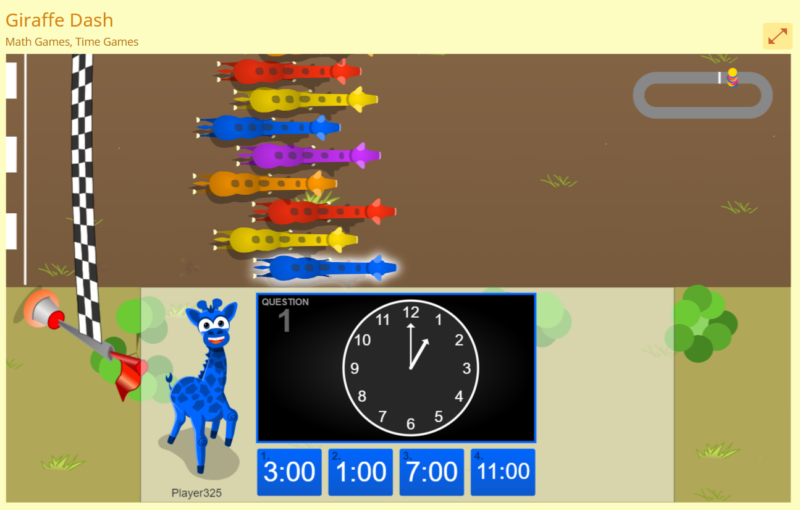
33. Race to the correct time
What’s more fun than playing a game with friends? We love that multiple players can play against one another as their adorable giraffe avatars race to be the first one across the finish line.
Learn more: Giraffe Dash
How do you teach telling time? Come exchange ideas in the We Are Teachers HELPLINE group on Facebook.
Plus, check out creative ways to dress up your classroom clock .
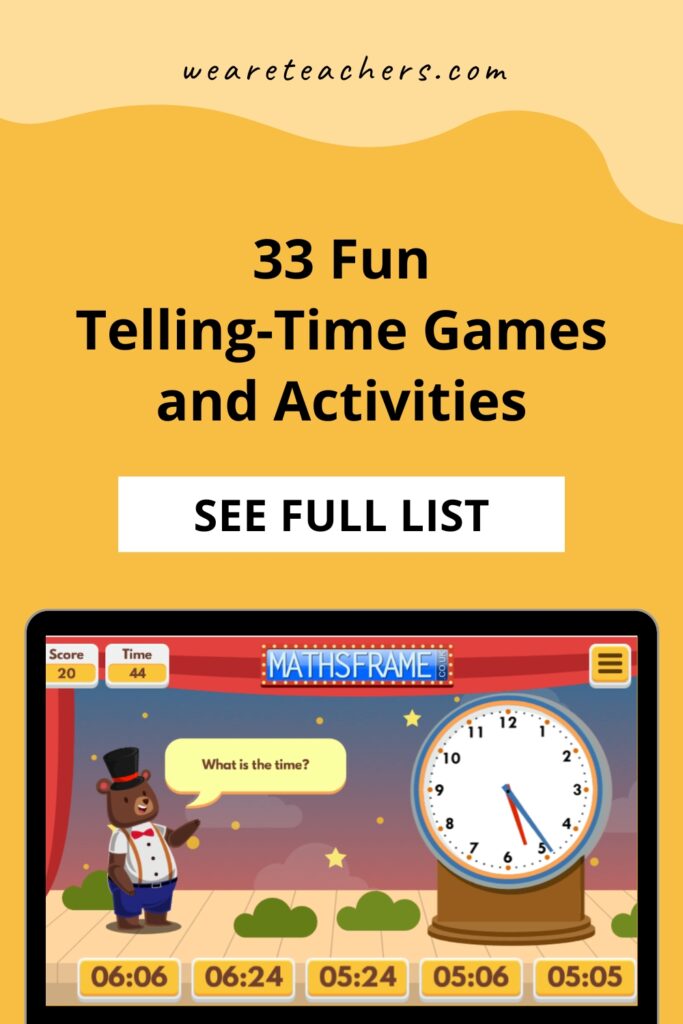
Copyright © 2024. All rights reserved. 5335 Gate Parkway, Jacksonville, FL 32256
- Number Charts
- Multiplication
- Long division
- Basic operations
- Telling time
- Place value
- Roman numerals
- Fractions & related
- Add, subtract, multiply, and divide fractions
- Mixed numbers vs. fractions
- Equivalent fractions
- Prime factorization & factors
- Fraction Calculator
- Decimals & Percent
- Add, subtract, multiply, and divide decimals
- Fractions to decimals
- Percents to decimals
- Percentage of a number
- Percent word problems
- Classify triangles
- Classify quadrilaterals
- Circle worksheets
- Area & perimeter of rectangles
- Area of triangles & polygons
- Coordinate grid, including moves & reflections
- Volume & surface area
- Pre-algebra
- Square Roots
- Order of operations
- Scientific notation
- Proportions
- Ratio word problems
- Write expressions
- Evaluate expressions
- Simplify expressions
- Linear equations
- Linear inequalities
- Graphing & slope
- Equation calculator
- Equation editor
- Elementary Math Games
- Addition and subtraction
- Math facts practice
- The four operations
- Factoring and number theory
- Geometry topics
- Middle/High School
- Statistics & Graphs
- Probability
- Trigonometry
- Logic and proof
- For all levels
- Favorite math puzzles
- Favorite challenging puzzles
- Math in real world
- Problem solving & projects
- For gifted children
- Math history
- Math games and fun websites
- Interactive math tutorials
- Math help & online tutoring
- Assessment, review & test prep
- Online math curricula
| → → Clock . Children start learning about clock and time when they are very young. Some children even learn to tell time before they start school. In kindergarten or 1st grade, children usually learn to tell time to the whole hour and half hours. Then in 2nd grade, they learn to tell time to the five-minute intervals and lastly in 3rd grade, tell time to the minute. (whole hours and half hours) (quarter hours and five minutes) (to the minute) Or, you can use the generator below to make customized worksheets as you like them: Telling time worksheets generator | Clock image size: |

Telling the Time
Related worksheets.
Read the time on an analogue clock. Lots of choice over levels, including: reading time to the nearest hour, half hour, quarter hour, five minutes or minute. Options include using a 24 hour clock and seeing how many correct answers you can get in a given time.
This new version will work on any tablet or computer.
For more measuring and time resources click here.

Game Objectives
New Maths Curriculum:
Year 2: Tell and write the time to five minutes, including quarter past/to the hour and draw the hands on a clock face to show these times
Year 3: Tell and write the time from an analogue clock, including using Roman numerals from I to XII, and 12-hour and 24- hour clocks
Year 4: Read, write and convert time between analogue and digital 12 and 24-hour clocks
Year 5: Solve problems involving addition and subtraction of units of measure (e.g. length, mass, volume, money) using decimal notation
Year 6: Measures
Primary Framework:
Use units of time (seconds, minutes, hours, days) and know the relationships between them; read the time to the quarter hour; identify time intervals, including those that cross the hours (Block D)
Read the time on a 12–hour digital clock and to the nearest 5 minutes on an analogue clock (Block D)
Read time to the nearest minute; use am, pm and 12-hour clock notation; choose units of time to measure time intervals; calculate time intervals from clocks and timetables (Block D)
Read timetables and time using 24-hour clock notation (Block D)
Click to choose an image or drag it here
- AI Math Solver

A Simple, Fast, and Intelligent AI Homework Helper

HomeworkAI Is The Ultimate AI Homework Helper You Need
Struggling with piles of homework and tricky assignments? Let HomeworkAI help you out! Our smart AI homework helper delivers detailed, step-by-step solutions, transforming study sessions into smooth sailing.
Covering all subjects, from complex calculus to intricate biology, our homework AI is here to ease the stress and boost your grades. Say hello to effortless learning and wave goodbye to study blues with HomeworkAI!

Get Instant Answers From Our Homework AI
Description: This is how to unlock comprehensive answers and master your studies with our homework AI, in a fast, accurate, and educational fashion.

Upload Your Assignment - Simply upload images, text files, or type your question to get started.

AI Processing - Our advanced AI homework helper will process your assignment and provide detailed, accurate solutions.

Learn & Understand - Review the step-by-step guidance to improve your knowledge and complete your homework with confidence.

Gain Academic Advantages From HomeworkAI's Top Features
Instant Solutions
Quick, clear-cut answers are just a click away with an instant AI homework helper—skip the headache and let our homework AI do the heavy lifting for you.
Maximum Accuracy
Count on Homework AI for spot-on answers. Our advanced AI algorithm digs deep into a vast knowledge base to ensure you get the most accurate solutions every time.
Around-the-Clock Help
Day or night, our homework AI is at your beck and call, ready to dismantle any academic obstacle you encounter, so learning never has to pause for a break.

Comprehensive Support
Whatever the subject, our intelligent AI homework helper has you covered. Get expert help from algebra equations to zoological classifications with ease.
Easy to Use
Enjoy a super user-friendly platform with our homework AI, tailored to empower students and academic professionals at every level to navigate through assignments with confidence.
Our Homework AI Can Help You With All Subjects !
Turn to HomeworkAI for tailored homework and assignment assistance in every subject of your choice.
Mathematics
Solve complex equations and tackle calculus challenges with our AI-powered homework helper that turns numbers into knowledge.
From cellular structures to ecosystem dynamics, easily manage your biology assignments with clear, detailed explanations.
Balance chemical equations and understand reaction mechanisms with a quick online problem solver that simplifies the periodic table.
Analyze literary themes and decipher figurative language with insights that breathe new life into classic texts.
Connect historical dots with ease, as HomeworkAI helps you interpret events and understand their lasting impacts.
Discover Success Stories with Our Homework AI
Ever since using HomeworkAI for my math homework, studying has been way less stressful, and I can say that I'm enjoying math now. My grades are up and I actually get the hang of algebra now!
- Priya K., University Sophomore
I was dreading chemistry all semester, but HomeworkAI totally turned that around. I'm now breaking down reactions and acing quizzes with confidence. The step-by-step solutions it provides are a lifesaver for someone like me! Totally recommended.
- Marcus D., High School Junior
HomeworkAI made sense of all those crazy bio terms I could never remember. HomeworkAI’s explanations have made it manageable. My test scores are also much better, and I'm not a bundle of nerves anymore!
- Lina J., College Freshman
No more panicking over biology assignments with this AI homework helper!! Nailed my biology midterm, all thanks to HomeworkAI! It's like having a tutor in my pocket, ready to help with homework anytime, day or night.
- Carlos M., High School Senior
Why HomeworkAI Is Your Go-To AI Homework Helper ?
| 💡 Intuitive AI assistance | Streamlined, user-friendly help at your fingertips |
|---|---|
| 🎓 Expertise across disciplines | Mastery of a multitude of subjects |
| 🚀 Boosted academic performance | Concrete solutions lead to better grades |
| 🌐 24/7 Accessibility | Get assignment help whenever you need |
| 📔 Homework simplified | Receive clear, concise solutions for your homework |
What types of files can I upload to HomeworkAI?
HomeworkAI supports a variety of file formats, including text files such as PDF, DOC, DOCX, and image files like JPEG and PNG. This allows you to easily upload assignments, worksheets, and questions in the format that best suits your needs.
Is HomeworkAI suitable for all educational levels?
Yes, HomeworkAI is tailored for students and educational professionals of all levels—from middle schoolers to university undergrads—providing support and solutions customized to each educational stage.
Can HoweworkAI process practice questions from textbook material?
Yes. Simply upload the textbook material with practice questions, and our homework AI will analyze them to provide detailed solutions and explanations, just as it would with any other homework assignment or study query.
Does getting help from HomeworkAI considered cheating?
HomeworkAI is an AI question answerer designed to aid your learning process, much like a traditional tutor. Thus, utilizing HomeworkAI may not be considered cheating, as long as it aligns with your institution's guidelines for using external help.
Can I use HomeworkAI to prepare for my exam?
Absolutely, HomeworkAI can be an effective tool for exam preparation. It offers practice questions, solutions, and thorough explanations to help reinforce your understanding of the subject matter, giving you an extra edge in your study routine.
How does HomeworkAI handle problems with multiple solution methods?
HomeworkAI does have the ability to handle problems with multiple solution methods. It can provide a primary solution and, where applicable, may offer alternative approaches or explanations to give you a well-rounded understanding of the problem at hand.

Get Your Hands on The Best AI Homework Helper Right Now !
HomeworkAI doesn't just deliver answers—it teaches problem-solving, becoming your ultimate homework companion.

Fundamental Lessons for Telling the Time
Use worksheets and other aids to help children learn time telling
- Math Tutorials
- Pre Algebra & Algebra
- Exponential Decay
- Worksheets By Grade
Children usually learn to tell time by first or second grade. The concept is abstract and takes some fundamental instruction before children can grasp the concept. You can use several worksheets to help children learn how to represent time on a clock and how to decipher the time on analog and digital clocks.
The Fundamentals
The concept of time may take some time to grasp. But, if you use a methodical approach to explaining how to tell what time it is, your students can pick it up with some practice.
24 Hours in a Day
The first thing that will help young students learn about time is if you explain to them that there are 24 hours in a day. Explain that the clock divides the day into two halves of 12 hours each. And, within each hour, there are 60 minutes.
For an example, you can explain how there is an 8 o'clock in the morning, like when children are getting ready for school, and an 8 o'clock at night, usually associated with bedtime. Show the students what a clock looks like when it is 8 o'clock with a plastic clock or another teaching aid. Ask the children what the clock looks like. Ask them what they notice about the clock.
Hands on a Clock
Explain to children that a clock has a face and two main hands. The teacher should demonstrate that the smaller hand represents the hour of the day while the larger hand represents the minutes within that hour. Some students may have already grasped the concept of skip counting by 5s, which should make it easier for children to understand the concept of each number on the clock representing 5-minute increments.
Explain how 12 at the top of the clock is both the beginning and end of the hour and how it represents ":00." Then, have the class count out the subsequent numbers on the clock, by skip counting by 5s, from 1 through 11. Explain how the smaller hash marks between numbers on the clock are minutes.
Go back to the example of 8 o'clock. Explain how "o'clock" means zero minutes or :00. Usually, the best progression for teaching children to tell time is to start in larger increments, like start with children only identifying the hour, then move to the half-hour, then the quarter hour, and then intervals of 5 minutes.
Worksheets for Learning Time
Once students understand that the small hour hand represents the 12-hour cycle and the minute hand points to 60 unique minutes around the clock face, they can begin practicing these skills by attempting to tell the time on a variety of clock worksheets.
- Blank clocks worksheet
- Telling time to the nearest 5 minutes
- Telling time to the nearest minute
- Two worksheets for filling in random times: Worksheet 1 and worksheet 2
- Fill in the digital times for analog clocks
- Miscellaneous time worksheets
Other Teaching Aids
Engaging multiple senses in learning helps support understanding and providing manipulatives and hands-on experiences enhance the learning experience.
There are many plastic-type clocks that are available to help children learn time concepts. If you can't find mini plastic clocks, have your students make paper clocks using a butterfly clip . When a child has a clock to manipulate, you can then ask them to show you various times. Or you can show them the digital time and ask them to show you what it looks like on an analog clock.
Incorporate word problems into the exercises, such as it is now 2 o'clock, what time will it be in a half an hour.
- First Grade Math: Telling Time by 5 Minutes
- 2nd Grade Worksheets
- 'I Have, Who Has?' Math Games
- Halloween Math Worksheets & Printable Activities
- First Grade Math Worksheets
- Simple Interest Worksheets With Answers
- Worksheets for Teaching Ordinal Numbers
- Geometry Practice: Perimeter Worksheets
- Factor Tree Worksheets
- Thanksgiving Math Worksheets and Activities for Kids
- Subtraction of Fractions With Common Denominators
- 9 Steps to a First Grade Lesson Plan for Telling Time
- Free Christmas Math Worksheets
- Worksheets to Help Kids Find Equivalent Fractions
- Practice Multiplication Skills With Times Tables Worksheets
- Teach Fractions Through Word Problems
- Our Mission
- Meet Team Prepped
- In the Press
- Test Preparation
- Curriculum Assistance Tutoring
- Special Needs Tutoring
- Executive Function Coaching
- College Application Essay Help and Coaching
- Testimonials
- Upcoming Events
- Free Tutoring Video Classes
- Helpful Videos
- Helpful E-Books
- Infographics
Time Management for Homework
Boost your academic success with expert advice, get the best study tips, test prep strategies, and academic insights delivered straight to your inbox..
Prepped and Polished has been featured on:

Tutor Aniela of Prepped and Polished teaches you better time management skills for your homework.
TRANSCRIPTION:
Hi there, it’s Aniela with Prepped and Polished. Thank you for joining us today. Today we’re gonna talk about time management for homework, how to set yourself up for success when attacking just a single day of homework assignments. So the number one thing you want to do is set a schedule for yourself. Maybe you have practice after school and you know you’re going to come home and eat and then attack your homework, but you need to set the time aside to actually complete the homework. So you might say, I’m gonna do my homework from 8:00 PM to 10:00 PM and that’s it, or maybe you don’t have practice right after school and you can come home and do your homework right away. I’m gonna sit down from 3:00 PM to 5:00 PM and do my homework. If you set an actual schedule for yourself, you are more likely to sit down and actually complete the work.
Step two is gonna be prioritizing. Make a list of what you have to do and make sure that you know when each assignment is due. Homework that’s due the next day is going to take priority and then anything that’s a long-term assignment or due maybe in two days is going to get pushed down lower on the list. Make sure that you also put timed periods for your assignments. If you have three or four different pieces of homework that you need to do, make sure that you time yourself, maybe give yourself 20 minutes to do your math, 20 minutes to do your English, to make sure that you get to each assignment. If you don’t finish them, that’s okay, you can come back to them at the end and finish them. But what happens often is that you think something’s going to take you 20 minutes and then you end up spending the entire two hour period completing one assignment and you don’t get the rest of your homework done. And making sure that you’re keeping yourself to your time limits, you’ll get to every piece of homework and you’ll keep yourself from getting too bored with a specific assignment to sort of wake yourself up if you have to switch tasks and change the brain and how it’s working from math to English, history to science, etc.
Last thing you’re gonna wanna do is make sure that you prep your workspace for success when attacking your homework. You’re probably going to get thirsty or hungry. Make sure that you have snacks and drinks with you so that you don’t get up and go to the kitchen and get distracted. You’re also gonna want to think about how to use your phone appropriately. It’s likely that you probably wanna listen to music while you’re doing your homework. That is totally okay, but make sure that you turn off all notifications for Snapchat, for Instagram, for your text messages. Put those notifications on complete silence so that you don’t get distracted by the group chats that you’re in every, you know, 10 seconds coming in and you won’t be able to focus on your work.
Just to recap quickly, to successfully set yourself up to attack your homework on a day to day basis, make sure that you’ve set actual time apart to complete homework. You prioritize assignments based on when they’re due. You set your space up for success in terms of having snacks, drinks. And making sure that your technology is being used appropriately during your homework time. If you found this video helpful, please give us a thumbs up and visit preppedandpolished.com.
Post your comments below:
Share This Story, Choose Your Platform!
Users agree that automated translations may not effectively convert the intended design, meaning, and/or context of the website, may not translate images or PDF content, and may not take into account regional language differences. Any person that uses the translated site does so at that person’s own risk. UGA Extension is not responsible for any damages, costs, liability, or risk associated with any use, functionality, and/or content of the website translations.
For more information, visit the Language Translation page.
Time Management: 10 Strategies for Better Time Management
The term Time Management is a misnomer. You cannot manage time; you manage the events in your life in relation to time. You may often wish for more time, but you only get 24 hours, 1,440 minutes, or 86,400 seconds each day. How you use that time depends on skills learned through self-analysis, planning, evaluation, and self-control. Much like money, time is both valuable and limited. It must be protected, used wisely, and budgeted.

- Are more productive.
- Have more energy for things they need to accomplish.
- Feel less stressed.
- Have more free time to do the things they want.
- Get more things done.
- Relate more positively to others.
- Feel better about themselves. (Dodd and Subdheim, 2005)
Finding a time management strategy that works best for you depends on your personality, ability to self-motivate, and level of self-discipline. By incorporating some, or all the ten strategies below, you can more effectively manage your time.
1. Know How You Spend Your Time
A time log is a helpful way to determine how you use your time. Record what you are doing in 15-minute intervals for a week or two. Evaluate the results:
- Did everything you needed to do get done?
- Which tasks require the most time?
- What time of day when you are most productive?
- Where is most of your time is devoted (i.e. job, family, personal, recreation)?
Identifying your most time-consuming tasks and determining whether you are investing your time in the most important activities can help you to determine a course of action. Having a good sense of the time required for routine tasks can help you be more realistic in planning and estimating how much time is available for other activities. Many apps exist to help you keep track of your time, as mentioned in Strategy 3.
2. Set Priorities
Managing your time effectively requires a distinction between what is important and what is urgent (MacKenzie, 1990). Experts agree that the most important tasks usually aren’t the most urgent tasks. However, we tend to let the urgent tasks dominate our lives. Covey, Merrill, and Merrill (1994) categorize activities into four quadrants in their Time Management Matrix: urgent, not urgent, important, and not important. While activities that are both urgent and important must be done, Covey et al. suggests spending less time on activities that are not important (regardless of their urgency) to gain time for activities that are not urgent but important. Focusing on these important activities allows you to gain greater control over your time and may reduce the number of important tasks that become urgent.
| Do these tasks as soon as possible. Examples: | Defer these tasks until all urgent and important tasks have been completed. Examples: | |
| Delegate these tasks to the appropriate people who can manage them. Examples: | Delete these tasks – they are often time wasters. Examples: |
Creating a "to do” list is an easy way to prioritize. Whether you need a daily, weekly, or monthly list depends on your lifestyle. Be careful to keep list-making from getting out of control. List manageable tasks rather than goals or multi-step plans. Rank the items on your “to do” list in order of priority (both important and urgent). You may choose to group items in categories such as high priority, medium priority, or low priority; number them in order of priority; or use a color-coding system. The goal is not to mark off the most items, but to mark off the highest priority items (MacKenzie, 1990). A prioritized “to do” list allows you to set boundaries so you can say “no” to activities that may be interesting or provide a sense of achievement but do not fit your basic priorities.
3. Use a Planning Tool

When using a planning tool:
- Always record your information on the tool itself. Jotting notes elsewhere that must be transferred later is inefficient and wastes more time.
- Review your planning tool daily.
- Keep a list of your priorities in your planning tool and refer to it often.
- Keep planning tools synchronized. If you keep more than one, make sure your phone, computer, and paper planning tools match.
- Keep a back-up system.
Apps on your phone can be great planning tools. Apps typically fall into one of the following categories:
- Time Trackers – Gain an awareness of how you spend your time.
- Time Savers – Increase productivity and break time-wasting habits.
- Task Managers – Prioritize and organize tasks to improve time management.
- Habit Developers – Create healthy habits to encourage time management.
4. Get Organized
Disorganization leads to poor time management. Research has shown that clutter has a strong negative impact on perceived well-being (Roster, 2016). To improve your time management, get organized.
Set up three boxes (or corners of a room) labeled "Keep," "Give Away," and "Toss." Sort items into these boxes. Discard items in your “Toss” box. Your "Give Away" box may include items you want to sell, donate, or discard.
The next step is to improve the time you spend processing information. For example, tasks such as email can eat up your day. To combat wasted time, implement an email organization system that allows you to process the information in each email as efficiently as possible. Use folders, flagging, or a color-coded system to keep track of what’s what.
5. Schedule Appropriately
Scheduling is more than just recording what must be done (e.g., meetings and appointments). Be sure to build in time for the things you want to do. Effective scheduling requires you to know yourself. Your time log should help you to identify times when you are most productive and alert. Plan your most challenging tasks for when you have the most energy. Block out time for your high priority activities first and protect that time from interruptions.
Schedule small tasks such as drafting an email, creating a grocery shopping list, reading, watching webinars or listening to podcasts for long commutes or when waiting for a call or appointment. Capitalize on what would otherwise be time lost. Avoid nonproductive activities, such as playing games or scrolling through social media. Limit scheduled time to about three-fourths of your day to allow for creative activities such as planning, dreaming, and thinking.
6. Delegate: Get Help from Others
Delegating means assigning responsibility for a task to someone else, freeing up your time for tasks that require your expertise. Identify tasks others can do and select the appropriate person(s) to do them. Select someone with the appropriate skills, experience, interest, and authority needed to accomplish the task. Be specific. Define the task and your expectations while allowing the person some freedom to personalize the task. Check how well the person is progressing periodically and provide any assistance, being careful not to take over the responsibility. Finally, reward the person for a job well done or make suggestions for improvements if needed. (Dodd and Sundheim, 2005). Another way to get help is to “buy” time by obtaining goods or services that save time. For example, paying someone to mow your lawn or clean your house, or joining a carpool for your children’s extracurricular activities frees time for other activities. The time-savings from hiring someone for specialized projects is often worth the cost.
7. Stop Procrastinating
People put off tasks for a variety of reasons. Perhaps the task seems overwhelming or unpleasant. To help stop procrastination, consider “eating the big frog first.” A quote commonly attributed to Mark Twain says, “If it’s your job to eat a frog today, it’s best to do it first thing in the morning. And if it’s your job to eat two frogs, it’s best to eat the big frog first.” Unpleasant tasks we procrastinate completing are “big frogs.” Complete these tasks as your first action of the day to get them out of the way. Another option is to “snowball” your tasks by breaking them down into smaller segments, completing preparatory tasks, and eventually completing the larger task at hand. Whether you choose the “big frog first” or “snowball” method, try building in a reward system for completed tasks to help stay motivated.
8. Manage Time-Wasters
Reduce or eliminate time spent in these activities by implementing some simple tips.
Handheld Devices
- Take advantage of voice-to-text features such as transcribed voicemails or to make notes or draft emails and text messages when you are on the go.
- Avoid small talk. Stay focused.
- Take any necessary action immediately following a call.
- Impose screen time limits and regularly monitor your digital wellness (see Strategy 10).
- Schedule breaks from your devices.
- Set aside a specific time to view and respond to email, but don’t let it accumulate to the point it becomes overwhelming to sort.
- Turn off notifications for email.
- Handle each item only once if possible.
- Immediately delete or unsubscribe from junk emails.
- Keep address books up-to-date and organized.
- Utilize built-in shortcuts to sort email.
Unexpected Visitors
- Schedule time for face-to-face visits.
- Inform visitors of your time constraints and politely offer to reschedule.
- Set a mutually agreeable time limit for the visit.
- When someone comes to the door, stand up and have your meeting standing to help keep it brief.
In-Person and Virtual Meetings
- Know the purpose of the meeting in advance.
- Arrive early.
- Start and end the meeting on time.
- Prepare an agenda and stick to it. Use a timed agenda, if necessary.
- Don’t schedule meetings unless they are necessary and have a specific purpose or agenda.
- Use recording software or designate a note-taker.
Family Obligations
- Use and sync virtual calendars for easy sharing between busy family members.
- Make each family member responsible for consulting the master calendar for potential conflicts.
- Create a central area or agreed upon app for posting communications such as appointment reminders, announcements, and messages.
9. Avoid Multi-tasking
Psychological studies have shown that multi-tasking does not save time. In fact, the opposite is often true. You lose time when switching from one task to another, resulting in a loss of productivity (Rubinsteim, Meyer, and Evans, 2001). Routine multi-tasking may lead to difficulty in concentrating and maintaining focus. Do your best to focus on just one task at a time by keeping your area clear of distractions, including turning off notifications on your devices, and set aside dedicated time for specific tasks.
10. Stay Healthy
The care and attention you give yourself is an important investment of time. Scheduling time to relax or do nothing helps you rejuvenate physically and mentally, enabling you to accomplish tasks more quickly and easily. Be sure to monitor your screen time as a part of your digital well-being, setting boundaries to stay healthy. A study conducted by Google showed that four out of five study participants who took steps to improve their digital well-being believe their overall well-being was positively impacted as well (Google, 2019). To improve your digital well-being, set time limits or utilizing built-in software on electronic devices such as phones and tablets to help maintain your digital wellness. Blue light blockers and grayscale mode may also help you improve your digital well-being. Set a time each night to shut off all digital devices to give your mind time to relax; this can also help improve your sleep schedule.
Unfortunately, poor time management and too much screen time can result in fatigue, moodiness, and more frequent illness. To reduce stress, reward yourself for time management successes. Take time to recognize that you have accomplished a major task or challenge before moving on to the next activity.
Whatever time management strategies you use, take time to evaluate how they have worked for you. Do you have a healthy balance between work and home life? Are you accomplishing the tasks that are most important in your life? Are you investing enough time in your own personal well being? If the answer is “no” to any of these questions, then reevaluate your time management strategies and transition to ones that will work better for you. Successful time management leads to greater personal happiness, more accomplishments at home and at work, and a more satisfying future.
Previously updated by: Roxie Price, University of Georgia Extension Dana Carney, University of Georgia Extension Rachael Clews, K-State Research and Extension
Originally written by: Sue W. Chapman, retired, UGA Extension Michael Rupured, retired, UGA Extension
Covey, S. R., Merrill, A. R., & Merrill, R. R. (1994). First things first: To live, to love, to learn, to leave a legacy . Simon & Schuster.
Dodd, P., & Sundheim, D. (2005). The 25 best time management tools and techniques: How to get more done without driving yourself crazy . Peak Performance Press, Inc.
Google, Global (DE, ES, FR, IT, PL, U.K., U.S.). (2019). Digital wellbeing survey (General population, 18+ years, n=97).
MacKenzie, A. (1990). The time trap (3rd ed.). American Management Association.
Roster, C., Ferrari, J., & Jurkat, M. (2016, March 16). The dark side of home: Assessing possession ‘clutter’ on subjective well-being. Journal of Environmental Psychology , 46 , 32–41. https://doi.org/10.1016/j.jenvp.2016.03.003
Rubinsteim, J., Meyer, D., & Evans, J. (2001). Executive control of cognitive processes in task switching. Journal of Experimental Psychology: Human Perception and Performance, 27 (4), 763–797. https://doi.org/10.1037/0096-1523.27.4.763
Status and Revision History Published with Full Review on Apr 25, 2014 Published with Minor Revisions on Aug 26, 2020 Published with Full Review on Feb 19, 2024
Have a question?
Related publications.
Does Homework Really Help Students Learn?
A conversation with a Wheelock researcher, a BU student, and a fourth-grade teacher

“Quality homework is engaging and relevant to kids’ lives,” says Wheelock’s Janine Bempechat. “It gives them autonomy and engages them in the community and with their families. In some subjects, like math, worksheets can be very helpful. It has to do with the value of practicing over and over.” Photo by iStock/Glenn Cook Photography
Do your homework.
If only it were that simple.
Educators have debated the merits of homework since the late 19th century. In recent years, amid concerns of some parents and teachers that children are being stressed out by too much homework, things have only gotten more fraught.
“Homework is complicated,” says developmental psychologist Janine Bempechat, a Wheelock College of Education & Human Development clinical professor. The author of the essay “ The Case for (Quality) Homework—Why It Improves Learning and How Parents Can Help ” in the winter 2019 issue of Education Next , Bempechat has studied how the debate about homework is influencing teacher preparation, parent and student beliefs about learning, and school policies.
She worries especially about socioeconomically disadvantaged students from low-performing schools who, according to research by Bempechat and others, get little or no homework.
BU Today sat down with Bempechat and Erin Bruce (Wheelock’17,’18), a new fourth-grade teacher at a suburban Boston school, and future teacher freshman Emma Ardizzone (Wheelock) to talk about what quality homework looks like, how it can help children learn, and how schools can equip teachers to design it, evaluate it, and facilitate parents’ role in it.
BU Today: Parents and educators who are against homework in elementary school say there is no research definitively linking it to academic performance for kids in the early grades. You’ve said that they’re missing the point.
Bempechat : I think teachers assign homework in elementary school as a way to help kids develop skills they’ll need when they’re older—to begin to instill a sense of responsibility and to learn planning and organizational skills. That’s what I think is the greatest value of homework—in cultivating beliefs about learning and skills associated with academic success. If we greatly reduce or eliminate homework in elementary school, we deprive kids and parents of opportunities to instill these important learning habits and skills.
We do know that beginning in late middle school, and continuing through high school, there is a strong and positive correlation between homework completion and academic success.
That’s what I think is the greatest value of homework—in cultivating beliefs about learning and skills associated with academic success.
You talk about the importance of quality homework. What is that?
Quality homework is engaging and relevant to kids’ lives. It gives them autonomy and engages them in the community and with their families. In some subjects, like math, worksheets can be very helpful. It has to do with the value of practicing over and over.

What are your concerns about homework and low-income children?
The argument that some people make—that homework “punishes the poor” because lower-income parents may not be as well-equipped as affluent parents to help their children with homework—is very troubling to me. There are no parents who don’t care about their children’s learning. Parents don’t actually have to help with homework completion in order for kids to do well. They can help in other ways—by helping children organize a study space, providing snacks, being there as a support, helping children work in groups with siblings or friends.
Isn’t the discussion about getting rid of homework happening mostly in affluent communities?
Yes, and the stories we hear of kids being stressed out from too much homework—four or five hours of homework a night—are real. That’s problematic for physical and mental health and overall well-being. But the research shows that higher-income students get a lot more homework than lower-income kids.
Teachers may not have as high expectations for lower-income children. Schools should bear responsibility for providing supports for kids to be able to get their homework done—after-school clubs, community support, peer group support. It does kids a disservice when our expectations are lower for them.
The conversation around homework is to some extent a social class and social justice issue. If we eliminate homework for all children because affluent children have too much, we’re really doing a disservice to low-income children. They need the challenge, and every student can rise to the challenge with enough supports in place.
What did you learn by studying how education schools are preparing future teachers to handle homework?
My colleague, Margarita Jimenez-Silva, at the University of California, Davis, School of Education, and I interviewed faculty members at education schools, as well as supervising teachers, to find out how students are being prepared. And it seemed that they weren’t. There didn’t seem to be any readings on the research, or conversations on what high-quality homework is and how to design it.
Erin, what kind of training did you get in handling homework?
Bruce : I had phenomenal professors at Wheelock, but homework just didn’t come up. I did lots of student teaching. I’ve been in classrooms where the teachers didn’t assign any homework, and I’ve been in rooms where they assigned hours of homework a night. But I never even considered homework as something that was my decision. I just thought it was something I’d pull out of a book and it’d be done.
I started giving homework on the first night of school this year. My first assignment was to go home and draw a picture of the room where you do your homework. I want to know if it’s at a table and if there are chairs around it and if mom’s cooking dinner while you’re doing homework.
The second night I asked them to talk to a grown-up about how are you going to be able to get your homework done during the week. The kids really enjoyed it. There’s a running joke that I’m teaching life skills.
Friday nights, I read all my kids’ responses to me on their homework from the week and it’s wonderful. They pour their hearts out. It’s like we’re having a conversation on my couch Friday night.
It matters to know that the teacher cares about you and that what you think matters to the teacher. Homework is a vehicle to connect home and school…for parents to know teachers are welcoming to them and their families.
Bempechat : I can’t imagine that most new teachers would have the intuition Erin had in designing homework the way she did.
Ardizzone : Conversations with kids about homework, feeling you’re being listened to—that’s such a big part of wanting to do homework….I grew up in Westchester County. It was a pretty demanding school district. My junior year English teacher—I loved her—she would give us feedback, have meetings with all of us. She’d say, “If you have any questions, if you have anything you want to talk about, you can talk to me, here are my office hours.” It felt like she actually cared.
Bempechat : It matters to know that the teacher cares about you and that what you think matters to the teacher. Homework is a vehicle to connect home and school…for parents to know teachers are welcoming to them and their families.
Ardizzone : But can’t it lead to parents being overbearing and too involved in their children’s lives as students?
Bempechat : There’s good help and there’s bad help. The bad help is what you’re describing—when parents hover inappropriately, when they micromanage, when they see their children confused and struggling and tell them what to do.
Good help is when parents recognize there’s a struggle going on and instead ask informative questions: “Where do you think you went wrong?” They give hints, or pointers, rather than saying, “You missed this,” or “You didn’t read that.”
Bruce : I hope something comes of this. I hope BU or Wheelock can think of some way to make this a more pressing issue. As a first-year teacher, it was not something I even thought about on the first day of school—until a kid raised his hand and said, “Do we have homework?” It would have been wonderful if I’d had a plan from day one.
Explore Related Topics:
- Share this story
Senior Contributing Editor

Sara Rimer A journalist for more than three decades, Sara Rimer worked at the Miami Herald , Washington Post and, for 26 years, the New York Times , where she was the New England bureau chief, and a national reporter covering education, aging, immigration, and other social justice issues. Her stories on the death penalty’s inequities were nominated for a Pulitzer Prize and cited in the U.S. Supreme Court’s decision outlawing the execution of people with intellectual disabilities. Her journalism honors include Columbia University’s Meyer Berger award for in-depth human interest reporting. She holds a BA degree in American Studies from the University of Michigan. Profile
She can be reached at [email protected] .
Comments & Discussion
Boston University moderates comments to facilitate an informed, substantive, civil conversation. Abusive, profane, self-promotional, misleading, incoherent or off-topic comments will be rejected. Moderators are staffed during regular business hours (EST) and can only accept comments written in English. Statistics or facts must include a citation or a link to the citation.
There are 81 comments on Does Homework Really Help Students Learn?
Insightful! The values about homework in elementary schools are well aligned with my intuition as a parent.
when i finish my work i do my homework and i sometimes forget what to do because i did not get enough sleep
same omg it does not help me it is stressful and if I have it in more than one class I hate it.
Same I think my parent wants to help me but, she doesn’t care if I get bad grades so I just try my best and my grades are great.
I think that last question about Good help from parents is not know to all parents, we do as our parents did or how we best think it can be done, so maybe coaching parents or giving them resources on how to help with homework would be very beneficial for the parent on how to help and for the teacher to have consistency and improve homework results, and of course for the child. I do see how homework helps reaffirm the knowledge obtained in the classroom, I also have the ability to see progress and it is a time I share with my kids
The answer to the headline question is a no-brainer – a more pressing problem is why there is a difference in how students from different cultures succeed. Perfect example is the student population at BU – why is there a majority population of Asian students and only about 3% black students at BU? In fact at some universities there are law suits by Asians to stop discrimination and quotas against admitting Asian students because the real truth is that as a group they are demonstrating better qualifications for admittance, while at the same time there are quotas and reduced requirements for black students to boost their portion of the student population because as a group they do more poorly in meeting admissions standards – and it is not about the Benjamins. The real problem is that in our PC society no one has the gazuntas to explore this issue as it may reveal that all people are not created equal after all. Or is it just environmental cultural differences??????
I get you have a concern about the issue but that is not even what the point of this article is about. If you have an issue please take this to the site we have and only post your opinion about the actual topic
This is not at all what the article is talking about.
This literally has nothing to do with the article brought up. You should really take your opinions somewhere else before you speak about something that doesn’t make sense.
we have the same name
so they have the same name what of it?
lol you tell her
totally agree
What does that have to do with homework, that is not what the article talks about AT ALL.
Yes, I think homework plays an important role in the development of student life. Through homework, students have to face challenges on a daily basis and they try to solve them quickly.I am an intense online tutor at 24x7homeworkhelp and I give homework to my students at that level in which they handle it easily.
More than two-thirds of students said they used alcohol and drugs, primarily marijuana, to cope with stress.
You know what’s funny? I got this assignment to write an argument for homework about homework and this article was really helpful and understandable, and I also agree with this article’s point of view.
I also got the same task as you! I was looking for some good resources and I found this! I really found this article useful and easy to understand, just like you! ^^
i think that homework is the best thing that a child can have on the school because it help them with their thinking and memory.
I am a child myself and i think homework is a terrific pass time because i can’t play video games during the week. It also helps me set goals.
Homework is not harmful ,but it will if there is too much
I feel like, from a minors point of view that we shouldn’t get homework. Not only is the homework stressful, but it takes us away from relaxing and being social. For example, me and my friends was supposed to hang at the mall last week but we had to postpone it since we all had some sort of work to do. Our minds shouldn’t be focused on finishing an assignment that in realty, doesn’t matter. I completely understand that we should have homework. I have to write a paper on the unimportance of homework so thanks.
homework isn’t that bad
Are you a student? if not then i don’t really think you know how much and how severe todays homework really is
i am a student and i do not enjoy homework because i practice my sport 4 out of the five days we have school for 4 hours and that’s not even counting the commute time or the fact i still have to shower and eat dinner when i get home. its draining!
i totally agree with you. these people are such boomers
why just why
they do make a really good point, i think that there should be a limit though. hours and hours of homework can be really stressful, and the extra work isn’t making a difference to our learning, but i do believe homework should be optional and extra credit. that would make it for students to not have the leaning stress of a assignment and if you have a low grade you you can catch up.
Studies show that homework improves student achievement in terms of improved grades, test results, and the likelihood to attend college. Research published in the High School Journal indicates that students who spent between 31 and 90 minutes each day on homework “scored about 40 points higher on the SAT-Mathematics subtest than their peers, who reported spending no time on homework each day, on average.” On both standardized tests and grades, students in classes that were assigned homework outperformed 69% of students who didn’t have homework. A majority of studies on homework’s impact – 64% in one meta-study and 72% in another – showed that take home assignments were effective at improving academic achievement. Research by the Institute for the Study of Labor (IZA) concluded that increased homework led to better GPAs and higher probability of college attendance for high school boys. In fact, boys who attended college did more than three hours of additional homework per week in high school.
So how are your measuring student achievement? That’s the real question. The argument that doing homework is simply a tool for teaching responsibility isn’t enough for me. We can teach responsibility in a number of ways. Also the poor argument that parents don’t need to help with homework, and that students can do it on their own, is wishful thinking at best. It completely ignores neurodiverse students. Students in poverty aren’t magically going to find a space to do homework, a friend’s or siblings to help them do it, and snacks to eat. I feel like the author of this piece has never set foot in a classroom of students.
THIS. This article is pathetic coming from a university. So intellectually dishonest, refusing to address the havoc of capitalism and poverty plays on academic success in life. How can they in one sentence use poor kids in an argument and never once address that poor children have access to damn near 0 of the resources affluent kids have? Draw me a picture and let’s talk about feelings lmao what a joke is that gonna put food in their belly so they can have the calories to burn in order to use their brain to study? What about quiet their 7 other siblings that they share a single bedroom with for hours? Is it gonna force the single mom to magically be at home and at work at the same time to cook food while you study and be there to throw an encouraging word?
Also the “parents don’t need to be a parent and be able to guide their kid at all academically they just need to exist in the next room” is wild. Its one thing if a parent straight up is not equipped but to say kids can just figured it out is…. wow coming from an educator What’s next the teacher doesn’t need to teach cause the kid can just follow the packet and figure it out?
Well then get a tutor right? Oh wait you are poor only affluent kids can afford a tutor for their hours of homework a day were they on average have none of the worries a poor child does. Does this address that poor children are more likely to also suffer abuse and mental illness? Like mentioned what about kids that can’t learn or comprehend the forced standardized way? Just let em fail? These children regularly are not in “special education”(some of those are a joke in their own and full of neglect and abuse) programs cause most aren’t even acknowledged as having disabilities or disorders.
But yes all and all those pesky poor kids just aren’t being worked hard enough lol pretty sure poor children’s existence just in childhood is more work, stress, and responsibility alone than an affluent child’s entire life cycle. Love they never once talked about the quality of education in the classroom being so bad between the poor and affluent it can qualify as segregation, just basically blamed poor people for being lazy, good job capitalism for failing us once again!
why the hell?
you should feel bad for saying this, this article can be helpful for people who has to write a essay about it
This is more of a political rant than it is about homework
I know a teacher who has told his students their homework is to find something they are interested in, pursue it and then come share what they learn. The student responses are quite compelling. One girl taught herself German so she could talk to her grandfather. One boy did a research project on Nelson Mandela because the teacher had mentioned him in class. Another boy, a both on the autism spectrum, fixed his family’s computer. The list goes on. This is fourth grade. I think students are highly motivated to learn, when we step aside and encourage them.
The whole point of homework is to give the students a chance to use the material that they have been presented with in class. If they never have the opportunity to use that information, and discover that it is actually useful, it will be in one ear and out the other. As a science teacher, it is critical that the students are challenged to use the material they have been presented with, which gives them the opportunity to actually think about it rather than regurgitate “facts”. Well designed homework forces the student to think conceptually, as opposed to regurgitation, which is never a pretty sight
Wonderful discussion. and yes, homework helps in learning and building skills in students.
not true it just causes kids to stress
Homework can be both beneficial and unuseful, if you will. There are students who are gifted in all subjects in school and ones with disabilities. Why should the students who are gifted get the lucky break, whereas the people who have disabilities suffer? The people who were born with this “gift” go through school with ease whereas people with disabilities struggle with the work given to them. I speak from experience because I am one of those students: the ones with disabilities. Homework doesn’t benefit “us”, it only tears us down and put us in an abyss of confusion and stress and hopelessness because we can’t learn as fast as others. Or we can’t handle the amount of work given whereas the gifted students go through it with ease. It just brings us down and makes us feel lost; because no mater what, it feels like we are destined to fail. It feels like we weren’t “cut out” for success.
homework does help
here is the thing though, if a child is shoved in the face with a whole ton of homework that isn’t really even considered homework it is assignments, it’s not helpful. the teacher should make homework more of a fun learning experience rather than something that is dreaded
This article was wonderful, I am going to ask my teachers about extra, or at all giving homework.

IMAGES
COMMENTS
It has three main modes, the first demonstrates how to tell the time using an analogue clock. The second mode uses the the clock hands as a way of learning angles. The third mode uses the clock as a way to help understand fractions. The clocked can be altered to change colors and its overall styling. Note in this activity different controls are ...
Conveniently, the clock features minute markers around the outside, helping young students learn to read the analog. Dash line circles, which can be toggled on or off in the lower left-hand corner, help students see which minute or hour the hands are pointing to. Turn the digital clock on or off using the button on the bottom right-hand corner.
Math Clock helps students become fluent working with time. Learners use analog clocks with geared or free-moving hands to learn how to tell time, explore jumps with count by numbers, and visualize story problems involving intervals of time. By placing and shading fraction overlays, students use the clock to contextualize fractions with frequently used denominators.
Free online interactive clock with draggable hands, 12/ 24 digital display, angles, protractor and fractions. Learn how to tell the time with movable hour and minute hands, also demonstrates angles, fractions and percentages.
These time worksheets are appropriate for 2nd, 3rd, and 4th Grade. Make a Calendar Worksheets. These time worksheets will make a yearly calendar for any year you enter between the range of the years 1800 and 3999. Time worksheets for learning to tell time. Produce clock faces for lesson plans or use for extra practice.
Color-coding supports student understanding and durable, geared clock hands are designed to last. From the Manufacturer. A great way to help kids grasp time-telling skills. Hidden gears maintain correct hour and minute relationships. Durable plastic clock has easy-to-read hour and minute markings.
Grade 3 time worksheets. Time phrases (e.g. "ten past 8") Draw the clock (5 and 1 minute intervals) Telling time (5 and 1 minute intervals) Elapsed time (forward / backward, 5 and 1 minute intervals) Estimating and rounding time. Converting units of time (years, months .... seconds) Reading a calendar. Months as ordinal numbers.
On this page you will find Time math worksheets including elapsed time, telling time on analog clocks, calendars and converting time worksheets. The calendars come in two different formats: yearly (all on one page) and monthly when you need extra space or a larger layout. The calendars are very useful in conjunction with the elapsed time ...
Help your child practice her time telling with this printable kindergarten worksheet. Telling Time with Melissa Mouse 2. Worksheet. In this kindergarten math worksheet, kids give Melissa Mouse a hand telling time. Kids will look at an analog clock, determine the time, and write the time. 50 States Time Zones.
Practice telling time with an analog clock using this great practice sheet. Click the checkbox for the options to print and add to Assignments and Collections. Challenge kids to think outside the digital box with these analog clock worksheets. Draw the time, write it in words, do match-ups and more.
Add tasks to work on today. Set estimate pomodoros (1 = 25min of work) for each tasks. Select a task to work on. Start timer and focus on the task for 25 minutes. Take a break for 5 minutes when the alarm ring. Iterate 3-5 until you finish the tasks.
Time and calendar worksheets. These grade 2 worksheets help students learn to read a traditional (analog) clock-face. We begin with "whole hours" (3 o'clock, etc.) and progress to half fours, quarter hours and 5 and 1 minute intervals. We also cover the units of time, am & pm, and elapsed time. Finally, we introduce the days of the week and ...
Natural Beach Living. 1. Make a paper clock. One of the trickier aspects of telling time is understanding how the number 1 also means 5 minutes, the number 2 means 10 minutes, and so on. This paper clock activity helps students make that connection. (Pro tip: Use paper plates to make this craft even easier.)
Telling time worksheets. Create an unlimited supply of worksheets for telling time on an analog clock or for drawing hands on a clock face when the time is given (grades 1-3)! The worksheets can be made in html or PDF format — both are easy to print. You can also customize them using the generator below. Children start learning about clock ...
Year 2: Tell and write the time to five minutes, including quarter past/to the hour and draw the hands on a clock face to show these times. Year 3: Tell and write the time from an analogue clock, including using Roman numerals from I to XII, and 12-hour and 24- hour clocks. Year 4: Read, write and convert time between analogue and digital 12 ...
Around-the-Clock Help. Day or night, our homework AI is at your beck and call, ready to dismantle any academic obstacle you encounter, so learning never has to pause for a break. Comprehensive Support. Whatever the subject, our intelligent AI homework helper has you covered. Get expert help from algebra equations to zoological classifications ...
Worksheets for Learning Time. Once students understand that the small hour hand represents the 12-hour cycle and the minute hand points to 60 unique minutes around the clock face, they can begin practicing these skills by attempting to tell the time on a variety of clock worksheets. Blank clocks worksheet.
4. Focus Booster. Availability: Android, iOS, macOS, Microsoft Windows, Web Cost: Free (Starter Plan), $4.99 per month or $54.89 per year (Professional Plan) Focus Booster aims to help users maximize productivity. Notably, the app utilizes the Pomodoro Technique — a time-management methodology that relies on timed sessions to keep users focused on single tasks.
I'm gonna sit down from 3:00 PM to 5:00 PM and do my homework. If you set an actual schedule for yourself, you are more likely to sit down and actually complete the work. Step two is gonna be prioritizing. Make a list of what you have to do and make sure that you know when each assignment is due.
Bartleby is the go-to, online homework help service for students everywhere. We pride ourselves in supporting students through their academic journeys and offer resources for every type of learner. We aim to help students finish homework fast so they can spend more time doing what makes them happy 😊. Subscribe.
Time Trackers - Gain an awareness of how you spend your time. Time Savers - Increase productivity and break time-wasting habits. Task Managers - Prioritize and organize tasks to improve time management. Habit Developers - Create healthy habits to encourage time management. 4.
Yes, and the stories we hear of kids being stressed out from too much homework—four or five hours of homework a night—are real. That's problematic for physical and mental health and overall well-being. But the research shows that higher-income students get a lot more homework than lower-income kids.
Yes! Textbook solutions are available on Quizlet Plus for $7.99/mo., while Chegg's homework help is advertised to start at $15.95/mo. Quizlet Plus helps you get better grades in less time with smart and efficient premium study modes, access to millions of textbook solutions, and an ad-free experience.